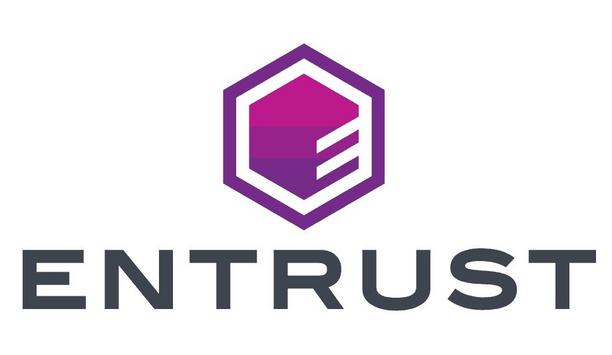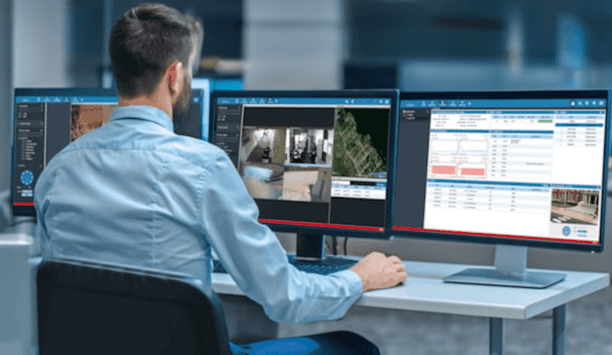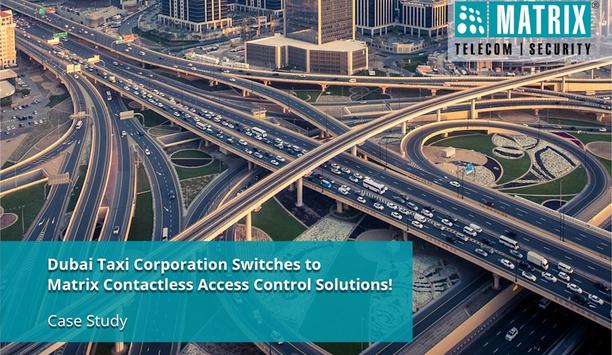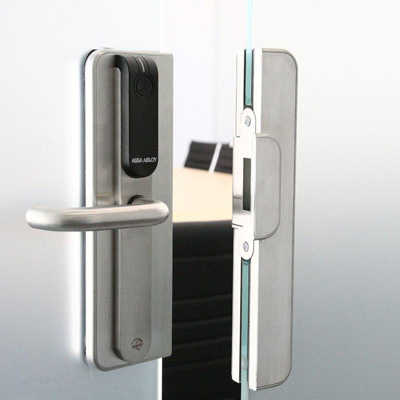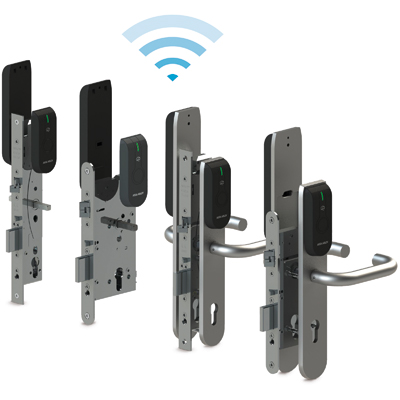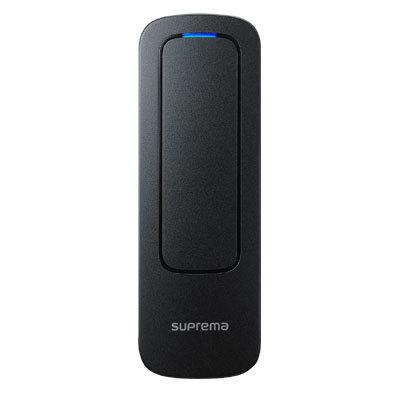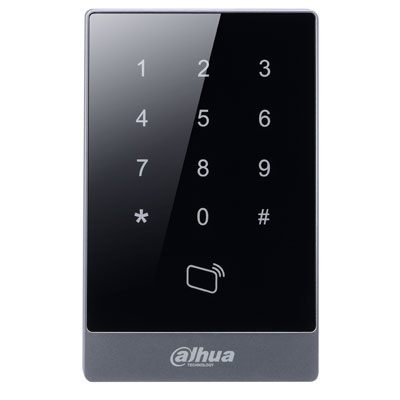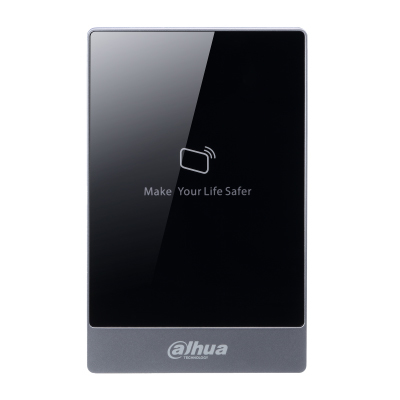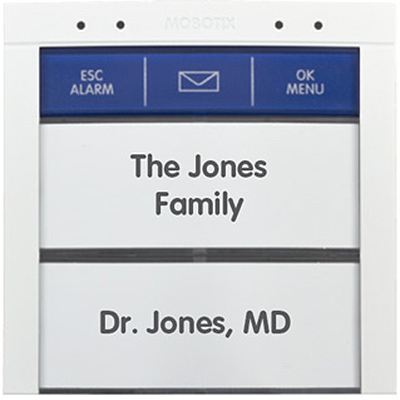Radio frequency Identification
Entrust, the pioneer in identity-centric security solutions, announced the Entrust Cryptographic Security Platform, the industry’s first unified, end-to-end cryptographic security management solution for keys, secrets, and certificates. Cyberattacks on data security and identity systems are exploding in scale and sophistication. Securing data and identities Traditional approaches to securing data and identities aren't working, and in digital-first environments, every connected dev...
AtlasIED, a pioneer in the security and commercial audio industries, announces the launch of its new Rapid Alert system, which includes the IP-PB wearable panic button and the IP-RC BLE-controlled relay board. This system is designed to enhance emergency communication and integrates seamlessly with AtlasIED’s IPX IP Endpoints, providing immediate accessibility to trigger notifications during critical events. Improving response times The IP-PB panic button is worn on a lanyard and conne...
HID, a pioneer in trusted identity solutions, introduces the HID Amico™ biometric facial recognition readers—designed to address the growing demand for secure, seamless and contactless access. This preview highlights the dependable choice for businesses prioritising convenience and security, with availability expected later in 2025. Advanced levels of security HID Amico provides advanced levels of security, reducing unauthorised access risks Leveraging industry-leading, NIS...
Allied Universal®, the world’s pioneering security and facility services company, announced its Unified Command Centre solution was recognised as an honourable mention in the 2025 Security Industry Association (SIA) New Products + Solutions (NPS) Awards - less than 30% of nominations received this recognition. The solution was honoured in the Managed Services category at the awards ceremony held at the ISC West conference this week in Las Vegas. Advancing security solutions &l...
Lanner Electronics, a pioneer in edge AI computing solutions, is proud to announce the launch of the EAI-I510 Edge AI Computer, designed to enhance city safety through AI-powered video analytics. Featuring the latest Intel® Core™ Ultra Series 2 (Arrow Lake H) processors, the EAI-I510 is engineered to support advanced video analytics applications such as intrusion detection, facial recognition, and law enforcement assistance for first responders. Real-time AI inference EAI-...
ThreatAware, the pioneering Cyber Asset Attack Surface Management (CAASM) provider, announced the launch of the new version of its cutting-edge platform designed to transform how organisations discover devices and manage their IT assets and security tools. Version 3.0 now enables the remediation of security issues discovered and uncovers previously unknown devices. ThreatAware’s platform ThreatAware’s platform provides a complete view of the IT infrastructure from a single screen...
News
Trend Micro Incorporated, a global cybersecurity pioneer, revealed a continued annual decline in its Cyber Risk Index (CRI) score. The figure stood at an average of 38.4 for the year, down by 6.2 points from 2023. The data shows a clear trend that organisations leveraging proactive security approaches are seeing measurable risk reduction. Proactive security with AI Rachel Jin, chief enterprise platform officer at Trend Micro: “Trend customers are embracing our vision for proactive security by using the AI-powered Trend Vision OneTM Cyber Risk Exposure Management to identify risk and prioritise mitigations.” “By getting on the front foot, they can build resilience, rapidly contain threats, and become more time and resource-efficient. It’s an approach that any organisation can emulate with the right mindset and tooling.” CRI score declined CRI score declined from 42.5 in February to 36.3 in DecemberThe CRI score declined each month throughout the year, from 42.5 in February to 36.3 in December. While organisations remain in the Medium Risk zone, the continued decline in CRI scores reflects real progress in cyber risk reduction. It highlights a growing shift toward continuous security assessment and risk-based decision-making. Yearly report highlight Among the highlights from this year’s report are: The report highlighted AI-assisted deepfake phishing, virtual kidnapping scams, and automated reconnaissance as key emerging AI threats Most risky events Risky cloud app access came top, followed by “stale Microsoft Entra ID account.” Rounding out the top 10 were email, user account and credential-related risks; many of them misconfiguration-related. Over one billion organisations were logged with multi-factor authentication disabled on Entra ID Accounts, highlighting a clear need for enhanced, automated identity security. Average Mean Time to Patch (MTTP) The top detected and unpatched CVEs from 2024 were “high severity” Elevation of Privilege (EoP) vulnerabilities published in the first half of the year. Europe (23.5 days) and Japan (27.5 days) recorded the fastest MTTP of any region, while non-profits (19 days) and the technology sector (22 days) were the fastest verticals. Healthcare (41.5 days) and telecoms (38 days) were slowest. Trend offers virtual patches to protect customers on average three months before official vendor updates. Industry breakdown Education, agriculture and construction had the highest CRI in 2024, singling them out as the most exposed sectors. Regional breakdown Europe was the most improved region, recording a seven-point CRI reduction—possible as a result of regulatory pressure from NIS2 and DORA. The Americas and AMEA have room to improve, while Japan maintained the lowest average (34.3). Ransomware LockBit, RansomHub, and Play ransomware were responsible for the highest number of reported breaches in 2024. According to Trend research, organisations with a CRI above average are around 12 times more likely to suffer a ransomware breach than those below average. AI The report highlighted AI-assisted deepfake phishing, virtual kidnapping scams, and automated reconnaissance as key emerging AI threats. However, AI can also empower network defenders to better predict and prevent cyberattacks, such as via the industry-first security LLM Trend Cybertron. Proactive steps for security Trend urges global organisations to embrace a proactive security approach To further lower their CRI, Trend urges global organisations to embrace a proactive security approach by: Optimising security settings to maximise product features and get alerts on misconfigurations, vulnerabilities, and other risks. And leveraging native sensors/third-party sources to build a comprehensive view of the attack surface. Contacting the device and/or account owner when a risky event has been detected to verify and investigate using the Vision One Workbench search function. Inventorying stale accounts to delete inactive and unused ones, disabling risky accounts, resetting passwords with strong credentials, and enabling multi-factor authentication (MFA). Applying the latest patches or upgrading application/OS versions regularly. Assessing cyber risk effectively Trend Vision One Cyber Risk Exposure Management uses its risk event catalogue to formulate a risk score for each asset type and an index score for organisations. It does this by multiplying an asset’s attack, exposure, and security configuration by asset criticality. The result is an integer between zero and 100 that falls into one of three levels: Low Risk (0-30), Medium Risk (31-69) and High Risk (70-100).
Sielox, the established industry pioneer in layered access control and crisis event management solutions, is demonstrating its latest security innovations at ISC West 2025 at stand 11109. Sielox is showcasing its flagship Pinnacle Access Control Platform that features hundreds of user-selectable filters, enabling security teams to aggregate and manage access data and events with unprecedented insights and visibility. Future of access control Sielox is showcasing its vision Pinnacle's intuitive automated access control features and streamlined workflows"At ISC West we’re highlighting the future of access control with real intelligence. Pinnacle, and our broader portfolio of layered solutions, empower security teams with the proactive insights they need to identify and mitigate evolving threats,” said Karen Evans, President and CEO of Sielox. “We're not just reactive. Sielox delivers proactive data-driven intelligence." Sielox is showcasing this vision with live demonstrations of Pinnacle's intuitive automated access control features and streamlined workflows. Visitors will experience how this comprehensive access control ecosystem creates layered protection that adapts to evolving security challenges while remaining remarkably easy to implement and manage. Next-gen access control solutions Alongside Pinnacle, Sielox is highlighting a variety of powerful security solutions designed to make access control smarter and more efficient, including: Sielox AnyWare A web-based access control platform that lets users monitor and manage security in real time from anywhere. It supports up to 64 doors and 25,000 cardholders and allows authorised personnel to manage security events instantly from any device, anywhere. This plug-and-play system operates via LAN, WAN, WiFi or cellular networks with no monthly fees, configuring in minutes while providing enterprise-grade protection with a lower total cost of ownership. 2700 Controller An intelligent, secure, and fully distributed access controller supporting up to 34 doors with continuous operation even during communication interruptions. This true IP controller features OSDP compatibility, wireless lock integration, and 32GB of memory for redundant configuration—all secured by an embedded Linux OS with AES 256 encryption. CLASS (Crisis Lockdown Alert Status System) Demo An award-winning real-time emergency alert and response system designed to improve communication and safety during critical situations. The solution provides colour-coded status updates on any device, features two-way chat between occupants and responders, and integrates with cameras and access control systems to enable faster, more coordinated emergency responses and real-time lockdown. WaveLynx integration A strategic partnership that enhances Sielox's access control ecosystem with WaveLynx's advanced reader and credential technologies, including secure mobile credentials via Bluetooth. This integration delivers superior security and convenience across financial, commercial, government, and educational environments—giving users flexible credentialing options for migrating from prox credentials. Pinnacle’s UI/UX unveiled “ISC West attendees can get a preview of the Pinnacle new UI and UX,” said Evans, “We encourage attendees to join the end users and CSIs who have guided our development with feedback and direction of their own.”
Quanergy Solutions, Inc., a provider of 3D LiDAR solutions, announces the full integration of its Q-Track™ 3D LiDAR platform with Bosch Video Management System (BVMS), a modular security system designed to manage video, audio, and data across large-scale security operations. This integration enables seamless interoperability between Quanergy’s high-precision LiDAR object detection and real-time tracking capabilities and Bosch’s industry-pioneer video management platform — allowing operators to make faster, more informed decisions in critical security environments. Critical security environments This integration enables seamless interoperability between Quanergy’s high-precision LiDAR object detection By combining the power of Quanergy Q-Track LiDAR with Bosch BVMS, operators can now access real-time 3D detection and tracking of objects, instantly paired with high-definition video verification from Bosch cameras. Additionally, the integration enables automated PTZ (pan-tilt-zoom) control, allowing cameras to dynamically follow detected objects in real time — significantly enhancing perimeter security and response efficiency. “Integrating our Q-Track platform with Bosch BVMS delivers significant advantages for enhanced perimeter security,” said Gerald Becker, VP Market Development & Alliances of Quanergy Solutions, Inc. “This collaboration empowers security teams to unify real-time 3D LiDAR tracking with high-quality video management, driving faster response times, significantly improving operational efficiency.” Time-consuming false alarms The integration of Quanergy Q-Track with Bosch BVMS delivers several key security benefits: Real-Time Object Detection & Video Verification: Quanergy’s LiDAR technology provides precise real-time detection and tracking of people and vehicles, while BVMS instantly pairs those detections with high-definition video from Bosch cameras for visual verification. Automated PTZ Camera Control: When Q-Track detects a person or vehicle crossing a defined perimeter, Q-Track can automatically direct Bosch PTZ cameras to zoom in and follow the object in real time. This ensures continuous visual coverage without requiring manual camera control, allowing operators to focus on rapid decision-making. Event-Based Triggers: The integration enables Q-Track to initiate event-based actions such as activating alarms, lights, or audible alerts when unauthorised movement is detected — significantly reducing response times. Streamlined Operator Workflow: Security operators can now manage all video feeds, LiDAR alerts, PTZ controls, and event responses through the familiar Bosch BVMS interface, simplifying operations and reducing the risk of missed incidents. Scalable and Resilient Infrastructure: Leveraging BVMS’ enterprise capabilities, operators can manage large-scale deployments across multiple sites, integrating LiDAR detection and video verification across thousands of cameras and locations. Minimised False Alarms: Q-Track’s 3D LiDAR perception software combined with Bosch’s high-resolution video allows operators to verify threats instantly, reducing costly and time-consuming false alarms. Strengthening perimeter protection “The ability to automatically control PTZ cameras based on real-time 3D LiDAR tracking is a game-changer for security operations,” said Becker. “This integration with Bosch BVMS not only strengthens perimeter protection but also improve response times — ensuring that security operators never miss critical events.” This integration is now available for all Quanergy Q-Track and Bosch BVMS users.
Trackforce, a pioneer in security workforce management software, and Immix, a provider of commercial central station and remote SOC software for managed video and security services, announced a strategic partnership to enhance remote guarding operations through advanced automation and seamless security event management. The collaboration integrates Trackforce’s comprehensive front-line to back-office suite, TrackTik, with the Immix platform to create an industry-first automation framework, optimising security operations centres (SOCs) and remote guarding service providers on a single platform. Security challenges “As security challenges evolve, organisations need smarter, more coordinated approaches to protecting people and property,” said Byron McDuffee, CEO of Trackforce. “Security teams are stretched thinner than ever, and the old ways of monitoring and dispatching don’t cut it anymore. By joining forces with Immix, we’re making it easier for security operations centres and remote guarding providers to react instantly, deploy resources efficiently, and keep people and property safer—without the bottlenecks of outdated, fragmented processes.” Immix’s incident identification and triage capabilities By integrating Immix’s incident identification and triage capabilities with TrackTik’s dispatch and reporting functionality, the partnership enables security organisations to: Automate Incident Response: Identify and process security events with minimal manual intervention. Enhance Compliance & Reporting: Ensure compliance with regulatory and insurance requirements through structured reporting workflows. Improve Operational Efficiency: Reduce response times and optimise security resource allocation across multiple sites. Unify Security Operations: Provide a centralised command and control platform for SOCs, allowing teams to monitor and manage security events across disparate systems. Automation and integrated systems The security industry is undergoing a rapid transformation, with technology-driven solutions The security industry is undergoing a rapid transformation, with technology-driven solutions reshaping the way companies approach threat detection, analysis and response. As organisations face labour shortages, rising security risks, and growing regulatory demands, automation and integrated systems have become essential to scaling security operations efficiently. Game-changer for remote guarding “Immix is constantly seeking ways to improve those ‘last mile’ elements that often create challenges within our industry,” said Chris Brown, CEO of Immix. “This partnership creates a seamless automation solution that receives, processes, dispatches, and reports events all in one place. It’s a game-changer for remote guarding providers, ultimately enabling them to offer better, more proactive service to their clients.”
Delta, a pioneer in power management and smart green solutions, highlighted at Hannover Messe 2025 a versatile set of AI-driven smart manufacturing, energy infrastructure, and data centre solutions. These include the award-winning D-Bot series cobots, featuring advanced cognitive capabilities and integration with NVIDIA Omniverse to develop next-generation digital twins; and DeltaGrid®, the AI-enabled energy management platform to optimise efficiency in the energy infrastructure supporting energy transition. AI-enabled solutions Shan-Shan Guo, Delta’s Chief Brand Officer, said, “Investments in both AI and public infrastructure are accelerating across the EMEA region. In the meantime, sustainability is even more important than ever. Our customers seek industrial solutions that can deliver both efficiency and resilience." "Delta‘s expertise in energy-efficient data centre infrastructure and AI-enabled solutions for smart manufacturing and energy management will empower businesses to unleash AI’s potential while achieving their sustainability goals.” Development of smart manufacturing Dalip Sharma, President and General Manager, Delta Electronics EMEA, said, “Our solutions are significantly contributing to the development of smart manufacturing and logistics, e-mobility, smart energy grids, and data centres across EMEA." "For example, over 30,000 of our high-efficiency charging systems are supporting more than half a million AGVs for a world-pioneering e-commerce enterprise while our PCS1500 series power conditioning systems are supporting a large-scale BESS project in the Netherlands. We look forward to collaborating even further with our partners at Hannover Messe 2025 to build an intelligent and sustainable future for the next-generation.” Spotlight on intelligent industry Elevating Smart Factories with Intelligent D-Bot Series Cobots Seamless integration increases efficiency and flexibility, unlocking new possibilities With the newly-launched Cognibot Kit, Delta's D-Bot series cobots feature AI functions and intuitive human-machine collaboration via the AI-Compute-Box. The system integrates sensors and AI for seamless operation, featuring 360° speech recognition, 3D object detection, gesture control, acoustic feedback, multimodal AI interaction, Wi-Fi, and an integrated 3D camera. With the Cognibot Kit, cognitive robotics become accessible to businesses of all sizes. Seamless integration increases efficiency and flexibility, unlocking new possibilities. Delta's Implementation of AI-Driven Automation with NVIDIA Omniverse Delta is leveraging NVIDIA Omniverse to drive AI-based automation at every level. This includes seamless integration with D-Bot cobots for real-time digital twins, enhancing safety through predictive collision avoidance and optimising performance with grip path training and AI model development. Furthermore, Delta utilises NVIDIA Omniverse and NVIDIA Isaac Sim for broader manufacturing applications, creating comprehensive digital twins of complex processes to facilitate advanced planning, simulation, and optimisation. Revolutionising Industrial e-Vehicles with Multi-Port and Wireless Charging MOOVair 03 delivers 3kW of high-performance wireless charging, charging current of 132A at 24V Delta’s newly launched MOOVbase Multi-Port Charging System is designed to simplify charging infrastructure for small logistics vehicles and battery swap stations. It enables simultaneous charging of up to three vehicles with different battery voltage levels using a single AC connection, delivering maximum flexibility and operational uptime. Another highlight is the extensive Wireless Charging System portfolio MOOVair. With power options ranging from 1kW to 30kW, the MOOVair facilitates efficient, hands-free charging for AGVs, forklifts, and tugs, significantly maximising fleet uptime and reducing maintenance. The MOOVair 03, a flagship model, delivers 3kW of high-performance wireless charging, charging current of 132A at 24V. Driving the energy transition AI-powered grid management DeltaGrid® is an advanced energy management platform designed to optimise energy consumption across diverse applications. By leveraging cutting-edge AI algorithms, it enables real-time control, seamless integration of renewable energy sources, and intelligent EV charging management. Purpose-built for commercial and industrial facilities, energy service providers, and EV charging operators, DeltaGrid® enhances operational efficiency, reduces energy costs, and supports organisations in achieving their sustainability goals. Comprehensive EV Charging Solutions High-performance solution leverages SiCMOS technology for high conversion efficiency Over 700 McDonald’s restaurants across France are supported by Delta’s UFC200 EV chargers deployed by strategic partner IZIVIA, demonstrating Delta’s leading position in EMEA. Highlights at Hannover Messe 2025 include the German Eichrecht-certified 500kW Ultra-Fast EV Charger, capable of charging two vehicles simultaneously at 250kW each. This compact, high-performance solution leverages SiCMOS technology for high conversion efficiency, ensuring fast and efficient charging for diverse EVs with accurate billing and all-weather reliability, making it ideal for high-demand environments. Next-Gen Energy Storage System Solution Delta’s latest Energy Storage Solution spotlights the DELTerra C, an all-in-one system with 125kW / 261 kWh capacity tailored for behind-the-meter applications. Delta introduces the DELTerra M1, featuring a compact 10-ft battery container design with flexible configurations This innovative solution features skid design for quick and easy installation, a fully liquid-cooled architecture with optimised energy density, and automatic State of Charge (SOC) calibration to reduce O&M costs. Scalable up to 10 units, the DELTerra C delivers exceptional flexibility to meet the energy demands of factories, commercial buildings, and EV charging stations. For utility-scale energy storage needs, Delta introduces the DELTerra M1, featuring a compact 10-ft battery container design with flexible configurations ranging from 708 kWh to 7.78 MWh — engineered to support large-scale renewable integration and enhance grid stability. Empowering digitalisation Delta offers reliable solutions to address the growing demands of modern data centres for reliability, efficiency, and scalability, such as the Xubus Edge, which offers ruggedised outdoor units providing high-availability infrastructure for mission-critical applications. For high-density data centres, Delta offers the Modulon DPH 500kVA Series UPS, a modular UPS with industry-leading power density (50kW per module) in a compact 3U space, ensuring high availability and manageability. Delta also presents its high-efficiency server power shelves, designed to deliver optimised efficiency and reliable power supply for AI factories and NVIDIA accelerated computing infrastructure. Welcome to Delta’s booth at Hall 11, Stand C05, and explore ways to collaborate on building a smarter, more sustainable, and interconnected future.
AMAG Technology announces Symmetry CompleteView Video Management 7.5, the latest software update to its video management system (VMS) platform. This version enhances operator experiences and introduces significant new enterprise capabilities including the integration of Iron Yun’s Vaidio® AI Video Analytics. Optimised monitoring The integration of Vaidio® AI Video Analytics supports both real-time monitoring and forensic investigationsThe integration of Vaidio® AI Video Analytics provides a comprehensive suite of advanced analytics for people, vehicles, facial recognition, and objects, compatible with any camera or video source. This enhanced solution supports both real-time monitoring and forensic investigations. Security operators benefit from immediate alerts and notifications, seamlessly integrated into the Live and Alarm View modules within Symmetry CompleteView. Investigators gain enhanced search capabilities, allowing them to review analytic alarm events directly in Symmetry CompleteView or leverage the Vaidio AI platform through a Symmetry CompleteView Web View for advanced analytic searches. Enhancing security with AI "Advanced analytics are now indispensable to any state-of-the-art VMS, transforming video management from a passive system into an intelligent, proactive security solution,” said AMAG Technology, Vice President of Product Development, Jennifer Marx. “By delivering both video management and analytics within a single, unified platform, we provide businesses of all sizes with cutting-edge technology that not only enhances security but also drives operational efficiency and strategic decision-making.” “This seamless integration ensures organisations can fully leverage the power of analytics—realising deeper insights, accelerating response times, and elevating their security posture to unprecedented levels." Federation for scalable security Federation enables a seamless user experience across multiple sites while eliminating a single point of failureDesigned to meet the demands of the enterprise market, Symmetry CompleteView VMS 7.5 also introduces federation, storage encryption, and export encryption. Federation enables a seamless user experience across multiple sites while eliminating a single point of failure, making it ideal for large, geographically distributed deployments. Native support for storage and export encryption safeguards video surveillance data at rest, ensuring it remains secure and properly handled for evidentiary use. Simplified mobile security The 7.5 release also improves the experience for operators with a new Android app and an updated iOS app. The mobile apps enable simple and secure remote access to live and recorded video. The video search capability now features enhanced timeline and playback controls, along with a more intuitive search parameter configuration, improving investigator efficiency. Symmetry CompleteView VMS deeply integrates with Symmetry Access Control to provide a unified security solution.
Trend Micro Incorporated, a global cybersecurity pioneer, revealed a continued annual decline in its Cyber Risk Index (CRI) score. The figure stood at an average of 38.4 for the year, down by 6.2 points from 2023. The data shows a clear trend that organisations leveraging proactive security approaches are seeing measurable risk reduction. Proactive security with AI Rachel Jin, chief enterprise platform officer at Trend Micro: “Trend customers are embracing our vision for proactive security by using the AI-powered Trend Vision OneTM Cyber Risk Exposure Management to identify risk and prioritise mitigations.” “By getting on the front foot, they can build resilience, rapidly contain threats, and become more time and resource-efficient. It’s an approach that any organisation can emulate with the right mindset and tooling.” CRI score declined CRI score declined from 42.5 in February to 36.3 in DecemberThe CRI score declined each month throughout the year, from 42.5 in February to 36.3 in December. While organisations remain in the Medium Risk zone, the continued decline in CRI scores reflects real progress in cyber risk reduction. It highlights a growing shift toward continuous security assessment and risk-based decision-making. Yearly report highlight Among the highlights from this year’s report are: The report highlighted AI-assisted deepfake phishing, virtual kidnapping scams, and automated reconnaissance as key emerging AI threats Most risky events Risky cloud app access came top, followed by “stale Microsoft Entra ID account.” Rounding out the top 10 were email, user account and credential-related risks; many of them misconfiguration-related. Over one billion organisations were logged with multi-factor authentication disabled on Entra ID Accounts, highlighting a clear need for enhanced, automated identity security. Average Mean Time to Patch (MTTP) The top detected and unpatched CVEs from 2024 were “high severity” Elevation of Privilege (EoP) vulnerabilities published in the first half of the year. Europe (23.5 days) and Japan (27.5 days) recorded the fastest MTTP of any region, while non-profits (19 days) and the technology sector (22 days) were the fastest verticals. Healthcare (41.5 days) and telecoms (38 days) were slowest. Trend offers virtual patches to protect customers on average three months before official vendor updates. Industry breakdown Education, agriculture and construction had the highest CRI in 2024, singling them out as the most exposed sectors. Regional breakdown Europe was the most improved region, recording a seven-point CRI reduction—possible as a result of regulatory pressure from NIS2 and DORA. The Americas and AMEA have room to improve, while Japan maintained the lowest average (34.3). Ransomware LockBit, RansomHub, and Play ransomware were responsible for the highest number of reported breaches in 2024. According to Trend research, organisations with a CRI above average are around 12 times more likely to suffer a ransomware breach than those below average. AI The report highlighted AI-assisted deepfake phishing, virtual kidnapping scams, and automated reconnaissance as key emerging AI threats. However, AI can also empower network defenders to better predict and prevent cyberattacks, such as via the industry-first security LLM Trend Cybertron. Proactive steps for security Trend urges global organisations to embrace a proactive security approach To further lower their CRI, Trend urges global organisations to embrace a proactive security approach by: Optimising security settings to maximise product features and get alerts on misconfigurations, vulnerabilities, and other risks. And leveraging native sensors/third-party sources to build a comprehensive view of the attack surface. Contacting the device and/or account owner when a risky event has been detected to verify and investigate using the Vision One Workbench search function. Inventorying stale accounts to delete inactive and unused ones, disabling risky accounts, resetting passwords with strong credentials, and enabling multi-factor authentication (MFA). Applying the latest patches or upgrading application/OS versions regularly. Assessing cyber risk effectively Trend Vision One Cyber Risk Exposure Management uses its risk event catalogue to formulate a risk score for each asset type and an index score for organisations. It does this by multiplying an asset’s attack, exposure, and security configuration by asset criticality. The result is an integer between zero and 100 that falls into one of three levels: Low Risk (0-30), Medium Risk (31-69) and High Risk (70-100).
Sielox, the established industry pioneer in layered access control and crisis event management solutions, is demonstrating its latest security innovations at ISC West 2025 at stand 11109. Sielox is showcasing its flagship Pinnacle Access Control Platform that features hundreds of user-selectable filters, enabling security teams to aggregate and manage access data and events with unprecedented insights and visibility. Future of access control Sielox is showcasing its vision Pinnacle's intuitive automated access control features and streamlined workflows"At ISC West we’re highlighting the future of access control with real intelligence. Pinnacle, and our broader portfolio of layered solutions, empower security teams with the proactive insights they need to identify and mitigate evolving threats,” said Karen Evans, President and CEO of Sielox. “We're not just reactive. Sielox delivers proactive data-driven intelligence." Sielox is showcasing this vision with live demonstrations of Pinnacle's intuitive automated access control features and streamlined workflows. Visitors will experience how this comprehensive access control ecosystem creates layered protection that adapts to evolving security challenges while remaining remarkably easy to implement and manage. Next-gen access control solutions Alongside Pinnacle, Sielox is highlighting a variety of powerful security solutions designed to make access control smarter and more efficient, including: Sielox AnyWare A web-based access control platform that lets users monitor and manage security in real time from anywhere. It supports up to 64 doors and 25,000 cardholders and allows authorised personnel to manage security events instantly from any device, anywhere. This plug-and-play system operates via LAN, WAN, WiFi or cellular networks with no monthly fees, configuring in minutes while providing enterprise-grade protection with a lower total cost of ownership. 2700 Controller An intelligent, secure, and fully distributed access controller supporting up to 34 doors with continuous operation even during communication interruptions. This true IP controller features OSDP compatibility, wireless lock integration, and 32GB of memory for redundant configuration—all secured by an embedded Linux OS with AES 256 encryption. CLASS (Crisis Lockdown Alert Status System) Demo An award-winning real-time emergency alert and response system designed to improve communication and safety during critical situations. The solution provides colour-coded status updates on any device, features two-way chat between occupants and responders, and integrates with cameras and access control systems to enable faster, more coordinated emergency responses and real-time lockdown. WaveLynx integration A strategic partnership that enhances Sielox's access control ecosystem with WaveLynx's advanced reader and credential technologies, including secure mobile credentials via Bluetooth. This integration delivers superior security and convenience across financial, commercial, government, and educational environments—giving users flexible credentialing options for migrating from prox credentials. Pinnacle’s UI/UX unveiled “ISC West attendees can get a preview of the Pinnacle new UI and UX,” said Evans, “We encourage attendees to join the end users and CSIs who have guided our development with feedback and direction of their own.”
Quanergy Solutions, Inc., a provider of 3D LiDAR solutions, announces the full integration of its Q-Track™ 3D LiDAR platform with Bosch Video Management System (BVMS), a modular security system designed to manage video, audio, and data across large-scale security operations. This integration enables seamless interoperability between Quanergy’s high-precision LiDAR object detection and real-time tracking capabilities and Bosch’s industry-pioneer video management platform — allowing operators to make faster, more informed decisions in critical security environments. Critical security environments This integration enables seamless interoperability between Quanergy’s high-precision LiDAR object detection By combining the power of Quanergy Q-Track LiDAR with Bosch BVMS, operators can now access real-time 3D detection and tracking of objects, instantly paired with high-definition video verification from Bosch cameras. Additionally, the integration enables automated PTZ (pan-tilt-zoom) control, allowing cameras to dynamically follow detected objects in real time — significantly enhancing perimeter security and response efficiency. “Integrating our Q-Track platform with Bosch BVMS delivers significant advantages for enhanced perimeter security,” said Gerald Becker, VP Market Development & Alliances of Quanergy Solutions, Inc. “This collaboration empowers security teams to unify real-time 3D LiDAR tracking with high-quality video management, driving faster response times, significantly improving operational efficiency.” Time-consuming false alarms The integration of Quanergy Q-Track with Bosch BVMS delivers several key security benefits: Real-Time Object Detection & Video Verification: Quanergy’s LiDAR technology provides precise real-time detection and tracking of people and vehicles, while BVMS instantly pairs those detections with high-definition video from Bosch cameras for visual verification. Automated PTZ Camera Control: When Q-Track detects a person or vehicle crossing a defined perimeter, Q-Track can automatically direct Bosch PTZ cameras to zoom in and follow the object in real time. This ensures continuous visual coverage without requiring manual camera control, allowing operators to focus on rapid decision-making. Event-Based Triggers: The integration enables Q-Track to initiate event-based actions such as activating alarms, lights, or audible alerts when unauthorised movement is detected — significantly reducing response times. Streamlined Operator Workflow: Security operators can now manage all video feeds, LiDAR alerts, PTZ controls, and event responses through the familiar Bosch BVMS interface, simplifying operations and reducing the risk of missed incidents. Scalable and Resilient Infrastructure: Leveraging BVMS’ enterprise capabilities, operators can manage large-scale deployments across multiple sites, integrating LiDAR detection and video verification across thousands of cameras and locations. Minimised False Alarms: Q-Track’s 3D LiDAR perception software combined with Bosch’s high-resolution video allows operators to verify threats instantly, reducing costly and time-consuming false alarms. Strengthening perimeter protection “The ability to automatically control PTZ cameras based on real-time 3D LiDAR tracking is a game-changer for security operations,” said Becker. “This integration with Bosch BVMS not only strengthens perimeter protection but also improve response times — ensuring that security operators never miss critical events.” This integration is now available for all Quanergy Q-Track and Bosch BVMS users.
Trackforce, a pioneer in security workforce management software, and Immix, a provider of commercial central station and remote SOC software for managed video and security services, announced a strategic partnership to enhance remote guarding operations through advanced automation and seamless security event management. The collaboration integrates Trackforce’s comprehensive front-line to back-office suite, TrackTik, with the Immix platform to create an industry-first automation framework, optimising security operations centres (SOCs) and remote guarding service providers on a single platform. Security challenges “As security challenges evolve, organisations need smarter, more coordinated approaches to protecting people and property,” said Byron McDuffee, CEO of Trackforce. “Security teams are stretched thinner than ever, and the old ways of monitoring and dispatching don’t cut it anymore. By joining forces with Immix, we’re making it easier for security operations centres and remote guarding providers to react instantly, deploy resources efficiently, and keep people and property safer—without the bottlenecks of outdated, fragmented processes.” Immix’s incident identification and triage capabilities By integrating Immix’s incident identification and triage capabilities with TrackTik’s dispatch and reporting functionality, the partnership enables security organisations to: Automate Incident Response: Identify and process security events with minimal manual intervention. Enhance Compliance & Reporting: Ensure compliance with regulatory and insurance requirements through structured reporting workflows. Improve Operational Efficiency: Reduce response times and optimise security resource allocation across multiple sites. Unify Security Operations: Provide a centralised command and control platform for SOCs, allowing teams to monitor and manage security events across disparate systems. Automation and integrated systems The security industry is undergoing a rapid transformation, with technology-driven solutions The security industry is undergoing a rapid transformation, with technology-driven solutions reshaping the way companies approach threat detection, analysis and response. As organisations face labour shortages, rising security risks, and growing regulatory demands, automation and integrated systems have become essential to scaling security operations efficiently. Game-changer for remote guarding “Immix is constantly seeking ways to improve those ‘last mile’ elements that often create challenges within our industry,” said Chris Brown, CEO of Immix. “This partnership creates a seamless automation solution that receives, processes, dispatches, and reports events all in one place. It’s a game-changer for remote guarding providers, ultimately enabling them to offer better, more proactive service to their clients.”
Delta, a pioneer in power management and smart green solutions, highlighted at Hannover Messe 2025 a versatile set of AI-driven smart manufacturing, energy infrastructure, and data centre solutions. These include the award-winning D-Bot series cobots, featuring advanced cognitive capabilities and integration with NVIDIA Omniverse to develop next-generation digital twins; and DeltaGrid®, the AI-enabled energy management platform to optimise efficiency in the energy infrastructure supporting energy transition. AI-enabled solutions Shan-Shan Guo, Delta’s Chief Brand Officer, said, “Investments in both AI and public infrastructure are accelerating across the EMEA region. In the meantime, sustainability is even more important than ever. Our customers seek industrial solutions that can deliver both efficiency and resilience." "Delta‘s expertise in energy-efficient data centre infrastructure and AI-enabled solutions for smart manufacturing and energy management will empower businesses to unleash AI’s potential while achieving their sustainability goals.” Development of smart manufacturing Dalip Sharma, President and General Manager, Delta Electronics EMEA, said, “Our solutions are significantly contributing to the development of smart manufacturing and logistics, e-mobility, smart energy grids, and data centres across EMEA." "For example, over 30,000 of our high-efficiency charging systems are supporting more than half a million AGVs for a world-pioneering e-commerce enterprise while our PCS1500 series power conditioning systems are supporting a large-scale BESS project in the Netherlands. We look forward to collaborating even further with our partners at Hannover Messe 2025 to build an intelligent and sustainable future for the next-generation.” Spotlight on intelligent industry Elevating Smart Factories with Intelligent D-Bot Series Cobots Seamless integration increases efficiency and flexibility, unlocking new possibilities With the newly-launched Cognibot Kit, Delta's D-Bot series cobots feature AI functions and intuitive human-machine collaboration via the AI-Compute-Box. The system integrates sensors and AI for seamless operation, featuring 360° speech recognition, 3D object detection, gesture control, acoustic feedback, multimodal AI interaction, Wi-Fi, and an integrated 3D camera. With the Cognibot Kit, cognitive robotics become accessible to businesses of all sizes. Seamless integration increases efficiency and flexibility, unlocking new possibilities. Delta's Implementation of AI-Driven Automation with NVIDIA Omniverse Delta is leveraging NVIDIA Omniverse to drive AI-based automation at every level. This includes seamless integration with D-Bot cobots for real-time digital twins, enhancing safety through predictive collision avoidance and optimising performance with grip path training and AI model development. Furthermore, Delta utilises NVIDIA Omniverse and NVIDIA Isaac Sim for broader manufacturing applications, creating comprehensive digital twins of complex processes to facilitate advanced planning, simulation, and optimisation. Revolutionising Industrial e-Vehicles with Multi-Port and Wireless Charging MOOVair 03 delivers 3kW of high-performance wireless charging, charging current of 132A at 24V Delta’s newly launched MOOVbase Multi-Port Charging System is designed to simplify charging infrastructure for small logistics vehicles and battery swap stations. It enables simultaneous charging of up to three vehicles with different battery voltage levels using a single AC connection, delivering maximum flexibility and operational uptime. Another highlight is the extensive Wireless Charging System portfolio MOOVair. With power options ranging from 1kW to 30kW, the MOOVair facilitates efficient, hands-free charging for AGVs, forklifts, and tugs, significantly maximising fleet uptime and reducing maintenance. The MOOVair 03, a flagship model, delivers 3kW of high-performance wireless charging, charging current of 132A at 24V. Driving the energy transition AI-powered grid management DeltaGrid® is an advanced energy management platform designed to optimise energy consumption across diverse applications. By leveraging cutting-edge AI algorithms, it enables real-time control, seamless integration of renewable energy sources, and intelligent EV charging management. Purpose-built for commercial and industrial facilities, energy service providers, and EV charging operators, DeltaGrid® enhances operational efficiency, reduces energy costs, and supports organisations in achieving their sustainability goals. Comprehensive EV Charging Solutions High-performance solution leverages SiCMOS technology for high conversion efficiency Over 700 McDonald’s restaurants across France are supported by Delta’s UFC200 EV chargers deployed by strategic partner IZIVIA, demonstrating Delta’s leading position in EMEA. Highlights at Hannover Messe 2025 include the German Eichrecht-certified 500kW Ultra-Fast EV Charger, capable of charging two vehicles simultaneously at 250kW each. This compact, high-performance solution leverages SiCMOS technology for high conversion efficiency, ensuring fast and efficient charging for diverse EVs with accurate billing and all-weather reliability, making it ideal for high-demand environments. Next-Gen Energy Storage System Solution Delta’s latest Energy Storage Solution spotlights the DELTerra C, an all-in-one system with 125kW / 261 kWh capacity tailored for behind-the-meter applications. Delta introduces the DELTerra M1, featuring a compact 10-ft battery container design with flexible configurations This innovative solution features skid design for quick and easy installation, a fully liquid-cooled architecture with optimised energy density, and automatic State of Charge (SOC) calibration to reduce O&M costs. Scalable up to 10 units, the DELTerra C delivers exceptional flexibility to meet the energy demands of factories, commercial buildings, and EV charging stations. For utility-scale energy storage needs, Delta introduces the DELTerra M1, featuring a compact 10-ft battery container design with flexible configurations ranging from 708 kWh to 7.78 MWh — engineered to support large-scale renewable integration and enhance grid stability. Empowering digitalisation Delta offers reliable solutions to address the growing demands of modern data centres for reliability, efficiency, and scalability, such as the Xubus Edge, which offers ruggedised outdoor units providing high-availability infrastructure for mission-critical applications. For high-density data centres, Delta offers the Modulon DPH 500kVA Series UPS, a modular UPS with industry-leading power density (50kW per module) in a compact 3U space, ensuring high availability and manageability. Delta also presents its high-efficiency server power shelves, designed to deliver optimised efficiency and reliable power supply for AI factories and NVIDIA accelerated computing infrastructure. Welcome to Delta’s booth at Hall 11, Stand C05, and explore ways to collaborate on building a smarter, more sustainable, and interconnected future.
AMAG Technology announces Symmetry CompleteView Video Management 7.5, the latest software update to its video management system (VMS) platform. This version enhances operator experiences and introduces significant new enterprise capabilities including the integration of Iron Yun’s Vaidio® AI Video Analytics. Optimised monitoring The integration of Vaidio® AI Video Analytics supports both real-time monitoring and forensic investigationsThe integration of Vaidio® AI Video Analytics provides a comprehensive suite of advanced analytics for people, vehicles, facial recognition, and objects, compatible with any camera or video source. This enhanced solution supports both real-time monitoring and forensic investigations. Security operators benefit from immediate alerts and notifications, seamlessly integrated into the Live and Alarm View modules within Symmetry CompleteView. Investigators gain enhanced search capabilities, allowing them to review analytic alarm events directly in Symmetry CompleteView or leverage the Vaidio AI platform through a Symmetry CompleteView Web View for advanced analytic searches. Enhancing security with AI "Advanced analytics are now indispensable to any state-of-the-art VMS, transforming video management from a passive system into an intelligent, proactive security solution,” said AMAG Technology, Vice President of Product Development, Jennifer Marx. “By delivering both video management and analytics within a single, unified platform, we provide businesses of all sizes with cutting-edge technology that not only enhances security but also drives operational efficiency and strategic decision-making.” “This seamless integration ensures organisations can fully leverage the power of analytics—realising deeper insights, accelerating response times, and elevating their security posture to unprecedented levels." Federation for scalable security Federation enables a seamless user experience across multiple sites while eliminating a single point of failureDesigned to meet the demands of the enterprise market, Symmetry CompleteView VMS 7.5 also introduces federation, storage encryption, and export encryption. Federation enables a seamless user experience across multiple sites while eliminating a single point of failure, making it ideal for large, geographically distributed deployments. Native support for storage and export encryption safeguards video surveillance data at rest, ensuring it remains secure and properly handled for evidentiary use. Simplified mobile security The 7.5 release also improves the experience for operators with a new Android app and an updated iOS app. The mobile apps enable simple and secure remote access to live and recorded video. The video search capability now features enhanced timeline and playback controls, along with a more intuitive search parameter configuration, improving investigator efficiency. Symmetry CompleteView VMS deeply integrates with Symmetry Access Control to provide a unified security solution.


Expert commentary
The adoption of innovative and interconnected door hardware systems can help overcome the challenges associated with building security, explains Daniel May of Consort Architectural Hardware. The security of our built environment and the safety of its people is paramount throughout a building’s lifecycle. While these elements remain a primary focus at each touchpoint of a construction project, today’s design teams are sooner adopting modern access control systems to address this age-old challenge, but why? Modern access control Where systems were once rudimentary, modern access control has evolved into a revolutionary factor of building design, unlocking various benefits for its many users in the process. The Internet of Things (IoT) has enhanced building security as we know it, and as technology continues to advance, more options enter the market. Following more than a decade of innovation and integration, the access control market is projected to grow year on year, from £7.8 billion in 2023 to £11.8 billion by 2028. Modern user requirements have led to several operational and technological advancements Modern user requirements have led to several operational and technological advancements during this period, and decision makers and design teams alike can now choose from a versatile selection of options. Some door hardware products now utilise smart locks, cloud control and even biometrics for example, and most recently, there’s been a substantial change to the way access control systems operate, with focus moving towards end users and ease of use. Modern access control has evolved into a revolutionary factor of building design Smart door hardware From an operational perspective, interconnected access control systems gift users with an intuitive network that improves building security through the use of real-time status updates, while also providing them with the ability to grant instant access approval and denial at the touch of a button. Often, users can operate their building’s various access points through their mobile phone, which has led to improved flexibility and efficiency in most environments - whether at home or in a public access property. The security benefits also become clear when compared to the alternative of physical keys. If a traditional key is lost or stolen, the security of a building becomes at risk until it is found or replaced. Intuitive access control systems are designed to build upon the traditional lock and key methods. By seamlessly integrating smart door hardware into both new and retrofit projects, users can manage access points and improve security across the building - without stifling ease of access, stunting future scalability or unsettling the aesthetics. Users can operate their building’s various access points through their mobile phone Access control system The PSIA standard is one of the widely recognised and respected standards for access control products As many adopt Wi-Fi infrastructures, NFC technology and cloud services into their buildings, decision makers must also consider the need for better standards. While the introduction of IoT may advance security, performance and functionality, it can also introduce new risks which must be mitigated by adhering to both localised and international standards, such as ISO 27001 for example. The Physical Security Interoperability Alliance (PSIA) standard is one of the widely recognised and respected standards for access control products and provides comprehensive requirements for systems by focusing on interoperability, scalability, and functionality. While the introduction of IoT may advance security, it can also introduce new risks Providing comprehensive requirements This standard ensures that access control products from different manufacturers can seamlessly integrate and communicate with each other, allowing for greater flexibility and choice when designing a complete access control system. After all, a one size fits all access control solution simply doesn’t exist and decision makers would be remiss in not selecting a product that aligns with their building’s needs while meeting the required standards.
The importance of data is ever-growing. For every profession, we’re witnessing the increasing reliance on data and its ability to promote efficiency for corporate decision-makers. The security industry is no different. The growing reliance on data and technological tools has allowed for a new breed of professionals with specialised skill sets. This evolution reflects the changing nature of security challenges in the digital age. The new security environment We know one thing from nearly every post-event analysis of a major security incident. Perpetrators frequently leave significant clues regarding their intentions. But identifying these risks is harder than ever. Security teams must manage greater threat data volumes through a wider range of channels. Security teams must manage greater threat data volumes through a wider range of channels Take the manufacturing sector, for example. Before the influx of data and technology, security teams may have been on the lookout for thieves conducting pre-operational surveillance in person at a plant. In the digital age, bad actors use social media to cooperate. In some well-organised theft rings, authorities have indicated that alleged buyers of stolen goods use apps to communicate with prospective thieves to streamline their process. Social engineering attacks In July 2020, hackers infiltrated Twitter's internal systems in a brazen cyberattack. Perpetrators tricked Twitter employees into revealing their login credentials via a social engineering technique called "phone spear-phishing." They compromised over 130 high-profile accounts, including former U.S. President Barack Obama, tech mogul Elon Musk, and Microsoft co-founder Bill Gates. Once inside, they utilised the company's internal tools to gain control of the targeted accounts and posted a series of tweets promoting a Bitcoin scam. The hackers promised to double any Bitcoin sent to a specified address and ultimately stole over $120,000 from unsuspecting users. This incident highlighted the vulnerability of even the most secure platforms to social engineering attacks and underscored the importance of implementing robust cybersecurity measures. Vast digital territories Leaders overseeing security and risk functions must establish a diverse team The rise of hybrid threats and the need to safeguard physical assets and vast digital territories has only expanded the concept of the company's perimeter. Fortunately, this same digital environment that fosters an expanded threat landscape can also enable security professionals with additional tools for identifying and eliminating risks. Leaders overseeing security and risk functions must establish a diverse team with a range of backgrounds and expertise to effectively utilise security tools and uncover hidden threats. As publisher and entrepreneur Malcolm Forbes eloquently stated, "Diversity is the art of thinking independently together." Public sector employees Traditional threats continue to pose a significant challenge, emphasising the ongoing value of experienced corporate security professionals, such as veterans and public sector employees. However, the emergence of contemporary asymmetric risks necessitates teams with a broader skill set. The emergence of contemporary asymmetric risks necessitates teams with a broader skill set The future of security demands a diverse collective of individuals drawing expertise from traditional backgrounds, such as three-letter government agencies, and non-traditional perspectives, such as data analysts. This fusion of diverse experiences and thought processes is crucial for devising holistic solutions to real-world risks. Traditional and contemporary threats In organisations I have been involved in, simply understanding our gaps and covering them with needed expertise was efficient in helping meld discussions about security with the language of business, which was a two-way street. Bringing on a program manager who understood the scrum framework made it far easier to align security's conversation and for security to understand the needs of its internal stakeholders. The security landscape demands individuals who excel in data visualisation, metrics analysis, and the ability to communicate security concepts in the language of business effectively. This blend of technical prowess and business acumen is essential for navigating the complexities of the modern security landscape. By embracing diversity in their security teams, organisations can harness the collective power of independent thinkers working together to address traditional and contemporary threats. This approach will empower organisations to build resilient security teams to safeguard their valuable assets in an ever-evolving threat landscape. Opening the door to new security talent For years, technology and data have grown to play a significant role in how security operates and evolves For years, technology and data have grown to play a significant role in how security operates and evolves. However, there remains a gap between how to effectively incorporate modern technology into legacy security programs. (There’s been some interesting research on this topic, including research out of the University of South California that identifies a lack of knowledge as a big barrier to using data and metrics by security teams.) As we transition into 2024 and the following years, developing analytical capabilities will remain essential for implementing and executing a comprehensive security strategy. Incorporating the expertise of digital natives, individuals who have grown up amidst recent technological advancements, or those with specialised knowledge in data visualisation and metrics analysis will ensure that this technology is utilised effectively, empowering teams to harness its full potential. Proactive risk mitigation Data analysts, for example, with their proficiency in handling large datasets, can play a pivotal role in identifying and mitigating potential security threats by analysing network traffic patterns, user behavior, and other pertinent data points, enabling proactive risk mitigation through predictive measures. These professionals play a critical role in translating complex security data into actionable insights These professionals play a critical role in translating complex security data into actionable insights, measuring the effectiveness of security measures, and aligning security strategies with overarching business goals. Bringing them on board may even create a flywheel effect. When recruiting for new team members, branching out and searching for candidates with non-traditional career backgrounds will open the door for more applicants with diverse and technological skills that fit modern security needs. Creating a holistic security program Fusing modern skills with traditional security expertise forms a holistic approach to security. It is a strategy capable of countering threats and demonstrating the tangible value of security investments to stakeholders in our interconnected world. In the same way that many security programs have shifted toward a centralised view of threats and vulnerabilities, teams composed of leaders from diverse backgrounds with modern skills combined with legacy security leaders will allow for a more comprehensive approach to security. This new security group will break free from the constraints of traditional methodologies and expand its capabilities to encompass a broader spectrum of risks. By combining insights from both seasoned security veterans and innovative digital natives, this team will deliver tangible value to a wider range of departments across the organisation. When security can proactively provide solutions and effectively address risks that arise in all corners of the organisation, it becomes the cornerstone of overall organisational safety. Modern security approaches This collaborative environment will empower the organisation to stay ahead of the curve Fostering a seamless interchange between traditional and modern security approaches will lay the foundation for a robust security program, where knowledge sharing among team members elevates the effectiveness of the entire program. This collaborative environment will empower the organisation to stay ahead of the curve and address the ever-evolving challenges of corporate security in a rapidly changing world. As we witness the future of security teams unfold, we will see a growing number of leaders emerge from the digital realm, bringing with them a deep understanding of risk management, emerging technologies, and data analytics. This infusion of fresh perspectives, coupled with the expertise of legacy leaders, will equip security teams to navigate the complex and ever-evolving landscape of corporate security. In his book "Risk: A User's Guide," Stanley McChrystal observed, ‘Generals who flawlessly fought the last war typically lose the one they're actually in—because conditions have changed and they haven't.’ This is true for leaders within the risk space, too. The security leaders of tomorrow must embrace change, adapt to new realities, and harness the power of diverse perspectives to safeguard their organisations in an ever-shifting environment.
Amidst the challenges of a prevailing economic downturn, the retail sector finds itself grappling with an unparalleled rise in incidents of shoplifting, theft, and burglaries. The disconcerting scenes witnessed on London’s Oxford Street in August 2023, where crowds gathered, looting as many stores as possible, sent shockwaves across the nation’s retailers. This alarming surge in retail crime has put retailers on high alert, as they contend with a rising tide of security concerns. Shoplifting concerns Recent data from the Union of Shop Distributive and Allied Workers (USDAW), has raised alarming concerns: shoplifting rates have surged by an unprecedented 24%. In the first half of 2023 alone, there were approximately 8 million reported shoplifting incidents. With the ongoing burden of the cost of living crisis and the approaching festive season, it is expected that these figures will keep surging. Implementing robust security measures Theft and prevention strategies cost retailers approximately £2 billion in 2021/2022 While more help from the Government to support retail workers and the businesses shoplifters target is certainly needed, the implementation of robust security measures will significantly contribute to deterring these crimes from occurring in the first place. British retailers spend millions on tools to deter and catch shoplifters inside stores, from CCTV and security guards to electronic tagging and alarms. The Grocer reported that theft and prevention strategies cost retailers approximately £2 billion in 2021/2022. Despite these initial costs, other threats are at play beyond the shop floor. Break-ins by criminal gangs For many large town centre stores and supermarkets, and units in retail parks, the rear doors and delivery areas are commonly targeted by criminal gangs. It’s not uncommon for thefts to occur from pallets or cages that have been unloaded from lorries and sit waiting to be moved into the building. After-hours break-ins are a risk for all store owners too, particularly over the festive season when a lot of high-value stock has been delivered to shops and supermarkets. Addressing anti-social behaviour The additional fencing was deemed an essential measure to safeguard the community Anti-social behaviour also poses a challenge for retailers. In 2022, an Aldi based in Derby invested in security fencing to protect staff and deter loitering groups. The additional fencing was deemed an essential measure to safeguard the community, as dangerous items were frequently found outside the store, including weapons and hypodermic needles. So how do physical security solutions such as fencing and gates help better protect retail establishments such as supermarkets and edge-of-town retail park shops? Fencing and gates: a critical component of retail security 1. Risk assessment and target hardening A thorough risk assessment will identify potential weak spots that require protection. ‘Target hardening’ involves implementing physical security measures that become more robust as they approach the target. This helps deter intruders while ensuring ease of access for customers and staff. 2. Effective perimeter security Opt for difficult-to-climb security fencing that provides a robust obstacle against thieves, vandals, and intruders Selecting fencing solutions according to the potential threats, site characteristics, and topography is crucial. It is important to specify fencing that strikes a balance and maintains a welcoming appearance while safeguarding external areas of the store or warehouse from potential harm and unauthorised access. Solid fencing which provides concealment can help to conceal expensive goods and remove them as a target for opportunistic theft. Opt for difficult-to-climb security fencing that provides a robust obstacle against thieves, vandals, and intruders. I recommend selecting a sufficiently tall and robust fence such as an acoustic barrier. Its noise-reducing properties are often beneficial for these types of sites too. 3. Controlling vehicular speeds and access To enhance security, consider controlling vehicular speeds and access. One effective approach is the installation of bollards at the ends of traditional high streets. This practice is already commonplace as a means of safeguarding against hostile vehicle attacks, but it can also play a pivotal role in preventing quick getaways of vehicles involved in potential heists. Additionally, employing road blockers and sliding gates at the rear entrances of delivery areas would serve to fortify security further. These measures can help in delaying vehicles, allowing for necessary checks to be conducted. 4. Balancing security with aesthetics The presence of high-security fencing can also make a site more of a target for vandals and burglars Another challenge is avoiding creating an imposing presence, especially important for areas situated near residential communities. The presence of high-security fencing can also make a site more of a target for vandals and burglars. To minimise this risk consider specifying timber fencing and traffic barriers to secure car parks, providing both security and a welcoming atmosphere for shoppers. Taking an integrated approach Combine secure perimeter fencing with effective lighting in places with shaded areas and at doors, gates, and shop windows, alongside Perimeter Intrusion Detection Systems (PIDS), and strategically placed CCTV. These measures will hinder unauthorised entry and escape, increasing the likelihood of detection and apprehension. Prioritising employee wellbeing Installing robust security fencing, complemented by CCTV, good lighting, and guarding, creates a safe environment Installing robust security fencing, complemented by CCTV, good lighting, and guarding, creates a safe environment for employees. This not only safeguards their well-being but also provides peace of mind that they are protected effectively in the case of a burglary or crime. When selecting security products for retail sites, it is advisable to opt for items that have undergone rigorous testing and carry relevant certifications for their security level. Each component should meet industry-specific standards for its intended purpose and originate from manufacturers accredited under ISO 9001:2015. This ensures a high standard of quality and reliability in safeguarding the premises. High-quality security fencing As the cost-of-living crisis continues, crime rates increase, and the festive season approaches, the time to act and implement on-site security is now. By investing in comprehensive security measures, retailers can protect their assets, employees, and customers, ensuring a safer and more secure shopping environment for all. High-quality security fencing is also a sound investment, that requires little or no maintenance once installed. The best fencing solutions are extremely weather-resistant, and won’t suffer from rust or corrosion. With all sectors preparing to ride the rapids of recession in the coming year, improving on-site security while selecting cost-effective measures, is one surefire way to protect your people, your property, and your profits from harm.
Security beat
Security professionals are recognising the intelligence value of leveraging publicly and commercially available information. This information can now be accessed more effectively from typically hard-to-reach regions. Also, the technological capabilities have matured in our age of artificial intelligence, machine learning, and data science. Intelligence has historically been based on classified data. However, today’s unclassified data, including open-source intelligence (OSINT), is increasingly being used to provide context and queuing for other types of intelligence. Advanced identity intelligence Babel Street is a technology company providing advanced identity intelligence and risk operations using an AI-enabled data-to-knowledge platform to unlock insights from a flood of data. The company provides advanced data analytics and intelligence for the world’s most trusted government and commercial organisations. Experts have predicted that by 2025 over 463 exabytes of data will be generated each day globally The sheer volume of data is growing exponentially. Experts have predicted that by 2025 over 463 exabytes of data will be generated each day globally. Not only are we seeing exponential growth in the volume of data, but there is also disparity in the veracity and the variety of data. This is being compounded by the ‘app economy’ in which data is created in a new format for every app added around the globe. Human language technology “The problem is that the data ‘junk’ and the ‘crown jewels’ are in the same bucket, and government and commercial entities need better and faster ways to extract intelligence from these torrents of data,” says Farid Moussa, VP, Strategy & Public Sector, Babel Street. Prior to joining Babel Street, Farid retired from the National Security Agency (NSA). He has guided video, image, speech, and text analytics (VISTA) and developed an appreciation for human language technology. An elusive source of data is the Dark Web, where every user, by design, is attempting to obfuscate their identity, and bad actors are hiding much better. “This presents a cat and mouse game – the cat must be smarter than the mouse, but the mouse is continually getting smarter,” says Moussa. Intelligence tools for data analysis SIGINT and HUMINT – while both vital – are also the most expensive forms of intelligence There are several intelligence tools for analysing data. One of them is signals intelligence (SIGINT), which refers to electronic transmissions collected by ships, planes, ground sites, or satellites. Another is human intelligence (HUMINT), which is collected in a human-to-human fashion. Open-source intelligence (OSINT) is obtained by searching on topics or entities of interest that are publicly available on the Internet at large. Today, these various categories are often done in ‘silos of excellence.’ However, the best practice is using all forms together in a holistic fashion. SIGINT and HUMINT – while both vital – are also the most expensive forms of intelligence, while OSINT, which is growing in importance, is most cost-effective. All are vital forms of intelligence; OSINT is complementary and crucial to holistic intelligence practices. Holistic intelligence practices When it comes to physical security of people and places, OSINT has become a critical source of actionable information. Security directors leverage Publicly Available Information (PAI) to safeguard against threats to individuals, property, travel routes, and event sites. By monitoring PAI, security teams can detect and respond to potential dangers, including during and after events where thorough preparation is vital. Online information can contain warning signs of impending threats. It informs security professionals in uncovering digital traces, confirming intentions, and addressing risks across language barriers, ensuring proactive risk management for the protection of people and property. Role of Natural Language Processing (NLP) The Internet and social media were mostly English language by default, but that has changed exponentially Natural Language Processing (NLP) is a crucial capability that has evolved to recognise the richness and variety of words and names in multiple languages and scripts, and their use across cultures. Using machine learning and linguistics algorithms, the technology simultaneously considers numerous types of name variations. At one time, the Internet and social media were mostly English language by default, but that has changed exponentially. Babel Street’s world-class entity matching technology measures over 100 features to calculate the similarity of entities across multiple languages. Despite advances in data management and the cloud, there are still multiple challenges and complexities with integration of these data elements. Challenges include spelling variances/phonetics, language translation issues, criminal evasion, human error upon input, typos, etc. Accessing data from a scattered landscape While there have been advancements in cloud technologies, agencies utilising open-source data are typically working within a highly scattered data landscape and must use a wide array of tools to get at the relevant pieces. This fragmentation makes it difficult to run analytics and apply AI and machine learning at scale in order to derive actionable insights. Unstructured and relationship data are visualised through advanced link analysis As with many disciplines, artificial intelligence (AI) is changing the game when it comes to intelligence. NLP and AI algorithms are employed to enhance datasets for greater quality, usability, and completeness. Unstructured and relationship data are visualised through advanced link analysis, geographic heat maps, influential entity carousels, topic clouds, and patterns by time and day. Geographic heat maps The advanced algorithms accurately score and prioritise critical entities within the relationship network while providing the citations from which an AI/ML-based decision was made. “With the democratisation of AI, the world is becoming flat,” says Moussa. “Just like the most prosperous countries, even the poorest countries have the most advanced capabilities to do damage. Third-world economies often present a scenario where the financial gain of nefarious schemes and low-to-no regulation combine to incentivise bad actors.” The Challenges of Name Matching Identity has been an ongoing challenge for intelligence analysis due to the vast complexity of linguistics, spelling and cultural variances, human error, as well as human evasion. Technology and data science approaches are maturing, however machine translation can still struggle with meaning. The best-of-breed natural language processing capabilities run against the data while it still is in its native language. This minimises the occurrence of analytic errors caused by inaccurate machine translations. This minimises the occurrence of analytic errors caused by inaccurate machine translations It’s tempting to think that name matching is like doing a keyword search. The complexity of language makes it more challenging. New names are constantly created, with multiple spellings and no set of rules to encompass how names are formed. They are variable across languages, scripts, cultures, and ethnicities. Culturally specific nicknames and aliases add to the complexity. Replacing human involvement The investigation of the Boston Marathon Bombing in 2013 spotlighted an example of the significance of intelligence analysis. Even though the FBI had issued a detain alert for Tamerlan Tsarnaev back in 2011, Tsarnaev managed to travel to Russia in January 2012; and in July 2012, he returned to Boston. He was not detained on either occasion because there were too many names on the lists, and Tsarnaev’s last name had been spelled differently from the way it was on travel documents, thus enabling him to get through security. With the Internet, social media, and the dark web, there’s been an exponential increase in public communications in various languages, adding significantly to the amount of analysis required to keep societies safe. Name matching, using AI, analyses multiple contextual data points across languages to arrive at matches. Name matching, using AI, analyzes multiple contextual data points across languages to arrive at matches A common misconception is that this technology will replace human intelligence. “It’s more accurate to recognise its role as a force-multiplier, allowing humans to focus on the on the harder problems and/or vetting the results of AI,” says Moussa. “The technology can efficiently analyse massive volumes of data and distill it into actionable information in a timely manner. It augments human capabilities, enabling analysis at speed and scale beyond human capacity, without replacing human involvement.” Commercial Technology to the rescue “When it comes to threat and identity intelligence, we face a risk-confidence gap, underscored by the challenge of integrating traditional tactics with the modern digital landscape,” adds Moussa. “We cannot ‘hire’ our way out of this problem. Instead, it is imperative that we adopt technology to scale our efforts and free humans to solve the harder problems that machines cannot solve yet.” The public sector loves to build things, but there are time-to-value and return-on-investment considerations to the ‘build or buy’ decision. When commercial technology can be leveraged by government, it frees resources up to work on problems that the commercial world hasn’t yet figured out, says Moussa. “The public and private sectors need to come together – one team, one nation, working together with mutual trust and collaboration,” he says.
Companies at GSX 2023 emphasised new ways that technologies such as artificial intelligence (AI) and the cloud can address long-standing issues in the security market. Among the exhibitors at the event in Dallas were companies seeking creative ways to apply technology, lower costs, and make the world a safer place. Reflecting on the exhibition, here are some additional takeaways. Expanding AI at the edge i-PRO is a company reflecting the continued expansion of edge AI capability in the security market. Today, more than half of the company’s lineup supports AI at the edge so the customer has a wide choice of form factors when seeking to leverage the feature set. AI processing relay, extended warranty i-PRO is increasing their warranty period from 5 to 7 years, which could be a lifetime warranty in some cases I-PRO also has an “AI processing relay” device that accepts non-AI video streams and applies edge analytics. AI has progressed from a high-end technology to a feature available in a variety of cameras at different price points. i-PRO is also increasing its warranty period from 5 to 7 years, which could be a lifetime warranty in some cases depending on a customer’s refresh schedule and lifecycle management. Active Guard, MonitorCast The company’s video management system (Video Insight) is continuing to build new features including “Active Guard,” an integrated metadata sorter. Their access control platform, MonitorCast, is a Mercury-based solution that is tightly integrated with Video Insight. Their embedded recorders now have PoE built in. “We can move at a faster pace to fill out our product line since leaving Panasonic,” says Adam Lowenstein, Director of Product Management. “We can focus our business on adapting to the market.” Emphasis on retail and other verticals Shoplifting is a timely issue, and retail is a vertical market that got a lot of attention at GSX 2023. “We see a lot of retailers who are primarily interested in protecting employee safety, but also assets,” says Brandon Davito, Verkada’s SVP of Product and Operations. “Shrinkage is a CEO-level priority.” “Retailers are getting more engaged with security posture, instead of letting perpetrators walk,” Davito adds. Intrusion detection Verkada has an intrusion product that will notify a central station if there is an alarm On the alarm side, Verkada has an intrusion product that will notify a central station if there is an alarm, and operators can review videos to confirm the alarm. Other capabilities seeking to discourage trespassers include sirens, strobes, and “talkdown” capabilities. International expansion Verkada continues to expand internationally with 16 offices in all, including Sydney, Tokyo, and London. The core value proposition is to enable customers to manage their onsite infrastructure more simply, including new elements such as PTZ cameras, intercoms, and visitor management. Verkada emphasises ease of use, including a mobile application to allow access to be managed across the user base. Forging partnerships “We are committed to the channel and industry, and we continue to build relationships and expand our reach,” says Davito. Among the industry relationships is a new partnership with Convergint, which was hinted at during the show and announced later the same day. They are also expanding their partnerships with Schlage, Allegion, and ASSA ABLOY. Working with other verticals They offer new features for K -12 schools, and a new alarm platform is easier to deploy and manage Verkada has also found success across multiple other verticals, notably healthcare, where they integrate with an electronic medical records system. They offer new features for K-12 schools, and a new alarm platform is easier to deploy and manage. They are integrating wireless locks to secure interior doors in schools, looking to secure the perimeter, and installing guest management systems. Transitioning the mid-market to the cloud Salient is squarely focused on the “mid-market,” a large swath of systems somewhere between small businesses and enterprise-level systems. Pure cloud systems are not as attractive to this market, which has a built-out infrastructure of on-premise systems. Adding a camera to an existing system is easier and less expensive than tying it to the cloud. Benefits of cloud It’s a market that may not be ready for the pure cloud, but there are benefits to be realised from adding a cloud element to existing systems. “We are continuing to augment our premise-based solutions with added cloud capabilities and flexibility,” says Sanjay Challa, Salient’s Chief Product Officer. The feedback Salient hears from their customers is “I want to own my data.” The hybrid cloud approach offers the right mix of control, flexibility, and unit economics. Cloud add-on capabilities We want to provide the flexibility for customers to go full-cloud as it becomes more economically attractive" Cloud add-on capabilities include bringing more intelligence about system operation to the user via the cloud. Over time, Salient expects to sell more cloud-centric offerings based on feedback from integrators and customers. “We want to provide the flexibility for customers to go full-cloud as it becomes more economically attractive over time,” says Challa. Vaidio AI technology Salient seeks to be a transition pioneer to help customers realise the path to the cloud. Their approach is “crawl, walk, run,” and helping customers make the transition at each stage. Salient has added AI to its product offering, incorporating Vaidio AI technology from IronYun into a powerful suite and broad array of on-premise analytics, which are gaining traction. The seamless approach makes it easy for customers to embrace AI analytics, although Salient remains broadly committed to open systems. Addressing ‘soft’ features for integrators AMAG is in the process of enhancing its product line with the next generation of access control panels. However, “product” is just part of the new developments at AMAG. In addition to “hard” features (such as products), the company is looking to improve its “soft” features, too; that is, how they work with the integrator channel. Integrator channel Rebuilding a process to make your organisation more efficient, is relatively easy; it just takes a lot of persistence" “We have the depth of our legacy customer base we can learn from, we just need to close the feedback loop quicker,” says Kyle Gordon, AMAG’s Executive Vice President of Global Sales, Marketing, and commercial Excellence, who acknowledges the value of reinstating face-to-face meetings after COVID. “We are laser-focused on nurturing our integrator channel,” he says. “Developing new features takes time, but rebuilding a process to make your organisation more efficient, that’s relatively easy; it just takes a lot of persistence,” says Gordon. More cohesive internal communication is another useful tool, he says. Disrupting the cloud based on price Wasabi is working to make cloud applications less expensive by offering a “disruptive” price on cloud storage, $6.99 per terabyte per month (80% less than hyperscalers). Contending “hyperscalers” like AWS are charging too much for cloud storage, Wasabi is using its own intellectual property and server equipment co-located in data centres around the world. Wasabi sells “hot cloud storage,” which refers to the fact that they only have one tier of storage and data is always accessible. In contrast, a company such as AWS might charge an “egress fee” for access to data stored in a “colder” tier. Cloud storage “We saw that several video surveillance companies had not yet adopted cloud storage, and we saw an opportunity to make it easy to use,” said Drew Schlussel, Wasabi’s Senior Director of Product Marketing. “We just install a little bit of software that allows them to store data in the cloud and bring it back from the cloud.” Performance, protection (cybersecurity), and price Wasabi works with integrators, resellers, and distributors and also integrates with VMS companies Wasabi works with integrators, resellers, and distributors and also integrates with VMS companies such as Genetec and Milestone. Emphasising performance, protection (cybersecurity), and price, their data centres are certified to SOC 2 and ISO 27001 standards. Faster throughput for weapons detection Xtract One is a young company focusing on weapons detection in a time of accelerated concern about gun issues post-COVID. Founded in Canada and based on technology developed at McMaster University, Xtract One has found a niche in providing weapons detection at stadiums and arenas. These customers already have budgets, and it is easy to shift the money to a newer, faster technology. Madison Square Garden in New York City is among its customers. Cost savings solution Xtract One can increase throughput to 30 to 50 people per entrance per minute (compared to 5 to 6 people per minute when using metal detectors). The solution doesn’t require anyone to empty their pockets and the system alarms on items beyond guns and knives. Using Xtract One allows customers to reduce the number of screening lanes and security staff, providing additional cost savings, all while getting fans through the screening process in half the time. Purpose-built sensors The system uses purpose-built sensors looking for specific characteristics, such as reflective and density properties In addition to stadiums and arenas, Xtract One, formerly Patriot One, is also getting “inbound” interest from schools, hospitals, manufacturers, and other verticals that makeup 50% of their business. “We’re on a rocket ride, mainly because the weapons issues are not going away,” says Peter Evans, CEO and Director at Xtract One. The system uses purpose-built sensors looking for specific characteristics, such as reflective and density properties, all correlated by an AI engine. Providing early warning of violence ZeroEyes is another company focused on weapons detection. Their AI gun detection system works with video images to identify if someone is “brandishing” (carrying) a weapon. In other words, the system does not detect concealed weapons. Identifying someone carrying a weapon provides early warning of a possible violent act. Increased response with AI-enables images Images are identified by AI and sent to a monitoring centre where a human confirms the image before contacting first responders. Knowing the location of a shooter enables staff to lock entry points, move people to safety, and direct first responders. The company was founded to leverage existing camera views to stop mass shootings and gun violence by reducing response times.
GSX 2023 has its share of new product announcements, although many of the new products are enhancements to technologies shown at last spring’s ISC West show in Las Vegas. Booth traffic on the first day seemed busy at the Kay Bailey Hutchison Convention Center in Dallas, although one exhibitor complained that it takes some time for the traffic to make its way to the farthest areas of the show floor. Apparent throughout the GSX show is an expanding idea of what constitutes security. Increasingly, ‘security’ technologies offer benefits throughout other parts of a company or institution. Security is also being broadened to encompass ‘safety,’ including emergency response and wider issues of keeping a company safe. Managing multiple systems People look at the systems they have, and they are looking for more information" Manufacturers at GSX are talking about more than new products. Rather, they are offering new approaches to turn products into ‘solutions’ for customers. Among the benefits of new systems is the availability of more data. “People look at the systems they have, and they are looking for more information and data and insights from their systems,” says Kyle Hurt, Genetec’s Area Vice-President of Sales for the US and Canada. “In the past, if I’m managing multiple systems and spending time and resources, I am making sure systems are operational. Today, it’s more like: How do I make my enterprise more efficient? I spend less time on making sure systems are working together but more time on how we can use the information.” Manufacturers at GSX are talking about more than new products Security control room Genetec is enhancing its Security Center 5.11 version with a newly redesigned web client that provides new capabilities related to system audio, including the ability to trigger a public address from a mobile device in an emergency, two-way audio to and from the security operations centre, and the ability to record an incident. The new web client offers new levels of “Security on the go,” says Hurt. A mobile device becomes an extension of the security control room. “Customers want to have more remote capabilities and have their security personnel out and about, not tied to a desk,” says Hurt. The new web client works to unify the four pillars of the Security Centre— video, access control, license plate recognition, and now audio. Single source manufacturer Audio can now be used to broadcast a message, respond to an incident, and notify people" “Audio has taken time to develop legs in our ecosystem,” says Hurt. “We have been developing partnerships and use cases beyond an intercom at the door. Audio can now be used to broadcast a message, respond to an incident, and notify people en mass of what’s going on.” Manufacturers are also fine-tuning how they work to meet customers’ needs. “Customers want one point of contact, a single source manufacturer, and a solution that reflects the manufacturer is listening to the voice of the customer,” says Jerry Burhans, Managing Director of ASSA ABLOY Global Solutions - Critical Infrastructure, which seeks to be a global partner to critical infrastructure industries. The Critical Infrastructure business works across the various product groups of the notoriously siloed company to bring together solutions aimed at meeting each customer’s need. Manufacturers are also fine-tuning how they work to meet customers’ needs Best-in-class technology “We try to have best-in-class technology and collaborate within ourselves to make sure we have what customers need,” says Burhans. Critical infrastructure industries such as water, power and energy, oil and gas are developing standards to help support preparedness of the nation’s infrastructure, and ASSA ABLOY Global Solutions is helping operators secure access and provide audit trails on locking hardware and keys within their security perimeters. Managing customer assets Johnson Controls’ new OpenBlue Service for the security device market seeks to proactively manage customer assets (equipment) as a service. The company’s software platform of connected solutions monitors and manages security devices across vendors and provides remote support services including skilled engineers who can work to ensure that a company’s assets, including cameras and access control readers, operate dependably. Working remotely, OpenBlue analyzes the performance of each system component Johnson Controls estimates that, unfortunately, up to 25% of a company’s security assets may not be working as intended, whether they lack the latest firmware update or are not connected. Working remotely, OpenBlue analyses the performance of each system component and responds to ensure equipment operates as intended. “We believe we can close that gap with our solutions,” says Greg Parker, Vice President, Innovation & Portfolio Management for Johnson Controls. Physical security equipment A big advantage of OpenBlue for security customers is the ability to manage cybersecurity and threats at the edge, which may not currently be addressed by the IT department. The OpenBlue offering includes an embedded ‘air wall,’ which is a zero-trust architecture for physical security equipment. OpenBlue also helps customers manage the ever-changing lifecycles of various assets. Another concept prompting discussion at GSX 2023 is the gap between what a customer expects from a product and what the product can realistically deliver. With endless promotion in the last several years centring on concepts such as artificial intelligence (AI), is it any wonder that customers may sometimes have unrealistic expectations about what a technology can accomplish? The good news at GSX is that, as progress marches on, newer technologies are getting closer and closer to delivering on customers’ most ambitious expectations. The forward momentum of technology development is evident throughout the GSX 2023 show floor, reflecting the promise of even greater product capabilities in months and years to come.
Case studies
Video wall systems installed by Ultimate Visual Solutions (UVS) at a major transport and security hub in the Midlands are approaching 50,000 hours of continuous 24/7 operation. UVS supplied and installed all equipment via its systems integrator partner TIS, which specialises in driving digital transformation and integration across the life safety, security and communications industry. Driving digital transformation The Transport for West Midlands Regional Transport Coordination Centre (RTCC) in Birmingham uses live data feeds and CCTV to monitor the transport network. It helps manage disruptions and is a hub for Transport for West Midlands, transport operators, emergency services and local authorities and played a key role in monitoring traffic and keeping people safe during the 2022 Commonwealth Games in Birmingham. Additional data sources In 2019, UVS installed 6x3 and 4x2 screen LCD video walls in the RTCC In 2019, UVS installed 6x3 and 4x2 screen LCD video walls in the RTCC. Both were supplied with a UVS Lucidity WBC video wall controller to allow the display of multiple IP CCTV feeds from around the region, in addition to multiple workstation inputs and web pages as additional data sources. UVS included a 65-inch interactive touch table integrated to RTCC sources and to the Lucidity video wall solutions, allowing data from the touch table to be displayed on the video wall. It also allows people to collaborate around the table and share data from various sources, in addition to controlling the video wall whilst there. Disaster recovery site UVS also included a desk mounted touch screen controller that allows fast launching of preset video wall layouts when needed for specific urgent incidents. In 2022 UVS added a third 4x2 video wall at the RTCC site, fed from one of the existing Lucidity controllers, which was expanded to deal with the additional outputs and inputs. Control of this remote video wall was provided via a Lucidity controller connected back to the RTCC At the same time, an identical 4x2 video wall was installed at a disaster recovery site approximately 15 miles from the RTCC site. This remote video wall is connected to the same outputs as the one at the RTCC, via HDMI-IP encoders. Control of this remote video wall was provided via a Lucidity controller connected back to the RTCC. Annual support contracts UVS Managing Director Steve Murphy said: “We are fortunate to have a great relationship with TIS which has enabled us to work together and with the client to provide a solution which has met their exact requirements and which is now on the verge of reaching 50,000 hours of continuous use in an environment where reliable 24/7 operation is vital.” “From the outset of the initial planning stages for the project, the client, TIS and UVS were also committed to system lifetime support. This consisted of annual support contracts for all technology by the TIS support team, with UVS providing a support contract for the complete video wall systems and accessories.” Complete video wall systems “This has ensured maximum operational uptime and efficiency and reassurance that all firmware and software updates and upgrades are provided on a regular basis, with priority support provided for any reported issues.” UVS, based in the Burnley First – Burnley Business Centre, is led by four senior colleagues who, between them, have more than 90 years’ combined Audio Visual, Control Room and Visual Solutions experience.
ZeroEyes, the creators of the only AI-based gun detection video analytics platform that holds the full US Department of Homeland Security SAFETY Act Designation, announces that the Northeastern School District (NESD) in York County, Pennsylvania has adopted ZeroEyes' AI gun detection and intelligent situational analysis solution. This proactive step will help protect students, staff, and visitors from gun-related threats. The cutting-edge security system identifies firearms in real-time and delivers actionable intelligence to first responders. Extensive security cameras Gun-related violence continues to be a pressing issue in the United States. Data from the ZeroEyes Gun Violence Research Center shows that 35.9% of shootings analysed in Pennsylvania occurred on K-12 school campuses. ZeroEyes’ technology will serve as a key additional layer of security to enhance these efforts NESD’s existing security measures include two full-time school resource officers and extensive security cameras. Additionally, the district is transitioning to electronic key card access for all doors, replacing traditional hard keys, and is reviewing remote lockdown capabilities and mass internal notification systems. ZeroEyes’ technology will serve as a key additional layer of security to enhance these efforts. Mass internal notification systems "A colleague introduced us to ZeroEyes, and we were immediately impressed by the potential of their AI gun detection technology," said Dr. Jason Bottiglieri, Superintendent of NESD. "When we learned about the Pennsylvania Commission on Crime and Delinquency (PCCD) grant, which focuses on enhancing school safety in Central Pennsylvania, we saw an opportunity to bring this critical solution to our district.” NESD is a midsized, suburban public school district located in the South Central region of Pennsylvania. NESD comprises eight buildings, including four elementary schools, two intermediate schools, one middle school, and one high school. The district serves over 4,000 students and employs approximately 300 teachers and 500-600 staff members. Law enforcement veterans If these experts determine the threat is valid, they dispatch alerts and actionable intelligence ZeroEyes’ AI gun detection and intelligent situational awareness software layers onto existing digital security cameras. If a gun is identified, images are instantly shared with the ZeroEyes Operations Center (ZOC), the industry’s only U.S.-based, fully in-house operation center, which is staffed 24/7/365 by specially trained U.S. military and law enforcement veterans. If these experts determine the threat is valid, they dispatch alerts and actionable intelligence — including visual description, gun type, and last known location — to local law enforcement and school security as quickly as 3 to 5 seconds from detection. Cutting-edge technology "It’s inspiring to see schools like NESD take decisive action to enhance campus security,” said Mike Lahiff, CEO and co-founder of ZeroEyes. “We are thrilled to support their mission to protect students, faculty, and staff. Our collaboration reflects a shared commitment to leveraging cutting-edge technology to help mitigate potential tragedies and save lives."
Victoria University City Tower is the largest vertical campus in Australia, consolidating all of the University’s operations and campuses in the CBD into one location. The 32-level building brings together select universities and TAFE courses located in the CBD. Courses include business, education and English, but also trades such as health and beauty. EQUANS were engaged as the audio-visual integrator for this construction project, supplying and installing multiple audio-visual systems throughout the campus. Video conference equipment EQUANS worked closely with Victoria University to deliver the audio-visual systems throughout the educational high rise. Meeting rooms, open area presentations, council rooms, teaching and learning rooms, simulation labs, spa, salon and hairdressing rooms and staff areas deployed Crestron video conference equipment as specified by the client. Utilising Crestron allowed EQUANS to deliver Fusion server integration, a smart system to communicate all communication and data requests and their status to the building manager in real time. This enables live updates on system performance, allowing the client and EQUANS to easily troubleshoot, remotely access the information and monitor equipment energy usage and adjust accordingly. Pre-commissioning field equipment To increase the efficiency of the build onsite, much of the work was done offsite In addition, the rollout of the unified Crestron video conferencing systems throughout the buildings provides a premium user experience for educators and students, ensuring they have a familiar user experience throughout the whole building. EQUANS forecasted COVID-19-related delays, mainly due to site restrictions and industry-wide equipment shortages. To increase the efficiency of the build onsite, much of the work was done offsite. This included scheduling equipment prior to build to ensure availability, pre-commissioning field equipment, and offsite system recommissioning including rack builds. Unified audio-visual systems Not only enabled these measures the project to be on time, but also within budget. Zero defects were found during the witness test after installation onsite, allowing EQUANS to confidently hand over the systems to Victoria University. Victoria University now boosts the latest audio visual systems, integrated into their state-of-the art educational facility. EQUANS is proud to be Victoria University’s long-standing audio-visual partner, delivering diverse audio-visual systems throughout the facility, catering to the unique requirements of each room type. Victoria University City Tower is now ready to welcome students and educators to learn and collaborate via unified audio-visual systems.
HID, the worldwide pioneer in trusted identity solutions, announces that the University of Dundee is updating its city campus estate implementing HID® Mobile Access® and signature HID Signo™ readers throughout its buildings to guarantee it has a modern, secure and reliable access control system to allow staff and students to enter using both RFID cards and smartphones. The project will involve buying and installing new mobile-ready HID Signo readers at around 40 buildings – a staged rollout being completed over a two-year period by specialist security installer, Scottish Communications Group. HID Mobile Access licences University has purchased 10,000 HID Mobile Access licences to offer its academic community In addition, the University has purchased 10,000 HID Mobile Access licences to offer its academic community the option to use their Apple and Android smartphones for touchless entry into its facilities. “We wanted a modern system which is safe, secure and easy for everyone to use,” says Colin Stebbing, the University’s Head of Precinct Services. HID solution: future-proof equipment Stebbing added: “Complying with forthcoming legislation was also another important project requirement. With bills like Martyn’s Law soon to be enacted, ensuring the University is ready for this was important given that we have a duty to protect to ensure everyone is safe." "The HID solution enables us to not only lock down buildings immediately, but it has built-in functionality which we can leverage over time, meaning we’ve invested in ‘future proof’ equipment which will last us long term.” Ambitious development plans University of Dundee is a research institute in Scotland, noted for its academic merit in dentistry The University of Dundee is a public research university in Scotland renowned for its academic excellence in dentistry, medicine, science and engineering and life sciences. Based in the heart of the city, it is home to over 16,000 students, 3,300 staff and is ranked 33rd in the Sunday Times Good University Guide 2024. A thriving institution with ambitious development plans, it is currently building a new £40 million facility called the Innovation Hub. This will offer commercial organisations flexible laboratory, meeting and office space and, over the next 10 years, it is anticipated the Hub will help create up to 280 new high-quality jobs. New HID Signo readers The new HID Signo readers integrate with the University’s existing AEOS access control software from Nedap. Supporting both native Bluetooth® and Near Field Communication (NFC) connectivity, they allow touchless smartphone entry and are fast to install as the wiring uses common protocols like OSDP (Open Supervised Device Protocol) and Wiegand. Furthermore, existing access cards already in circulation can be used with the new HID Signo readers, thereby speeding up the rollout. RFID cards access buildings The university used to print and issue plastic RFID cards so staff and students could access buildings Historically, the University used to print and issue plastic RFID cards so staff and students could access buildings. This process was laborious and time-consuming, especially during peak times like Freshers Week, when some 2,500 – 3,000 undergraduate and postgraduate students enrol. Issuing cards was logistically complex due to the high demand and the need for thorough identity checks, which could take up to 10 minutes per card. HID Origo management software Shifting to HID Mobile Access – which utilises cloud-based HID Origo management software integrating with the AEOS system – completely changes this and delivers wireless credentialling. This significantly simplifies all the licencing, allocation of credentials, setting of building access rights, validating or revoking of IDs – all of which is now done virtually and remotely. Improve the mobile credential “Once registered by Student Services in AEOS, a student simply gets an email to their phone, they tap on a link, the app automatically uploads and a mobile credential is granted,” says Paul Brady, HID’s End User Business Manager for Physical Access Control Solutions. “Not only does this improve the overall student experience because it’s substantially quicker and more efficient, but it’s far more sustainable as you’re not issuing PVC cards anymore.” Integrate with digital campus cards While the strategy and aspiration are for the university population to shift wholesale to mobile access While the strategy and aspiration are for the university population to shift wholesale to mobile access, its approach now is to operate a dual system. “We recognise that some visitors and staff still want to use a physical pass and not all employees have a university-issued mobile credential,” explains Stebbing. “HID Signo readers allow us to run both credential types in tandem, with HID Mobile Access giving us the option to scale up to include digital wallets from Apple and Google, as well as integrate with digital campus cards should we decide to go down this route in the future.” FARGO range of ID card printers Given that RFID cards are still required now, the University of Dundee utilises its reliable FARGO DTC4500e printers to back up this transition to digital transformation. The FARGO range of ID card printers integrates easily with the AEOS software so that Student Services staff can easily issue physical IDs themselves. HID’s reputation University of Dundee utilises its FARGO DTC4500e printers to back up this shift to digital change “HID Signo readers are going in now across the main buildings, including the new Innovation Hub site,” says Stuart Leslie, Scottish Communications Group’s director. “HID’s reputation is built on reliability and security with its solutions supporting the latest encryption, communications and authentication standards. Their devices have an open architecture so they’re easy to install and integrate which reduces the cost for the university and makes time to value that much quicker.” MOTORTRBO Ion smart radios In addition, Scottish Communication Group is supplying Motorola MOTORTRBO Ion smart radios to the University’s security staff. The radios will be configured to run HID Mobile Access so they can open doors fitted with the new HID Signo readers. Because these smart radios also link to the University’s CCTV, alarm systems and CriticalArc Safezone® App, security staff need carry only a single device to fulfil their duties.
ZeroEyes, the creators of the only AI-based gun detection video analytics platform that holds the full U.S. Department of Homeland Security SAFETY Act Designation, announces that its proactive gun detection and intelligent situational awareness solution has been deployed by Berrien Springs Public Schools (BSPS) in Michigan to mitigate gun-related violence. The company and district are also partnering to present ‘Lunch & Learn: Protecting Schools from Active Shooter Events,’ an in-depth safety and security seminar, ZeroEyes demo for surrounding schools, and Q&A to take place May 12th at 11:30 am in the STEM Central Building. Safe learning environment Located in the southwestern corner of the state, BSPS’ main campus sits in the heart of Berrien County and includes six schools: Mars Elementary, Sylvester Elementary, Berrien Springs Middle School, Berrien Springs High School, Virtual Academy, and Discovery Academy. Additionally, beyond its main campus, the district supports 28 additional learning centers statewide through an alternative learning program that helps students earn their high school diploma under the Michigan Merit Curriculum guidelines. The district has implemented ZeroEyes to further strengthen its multilayered security approach Serving approximately 7,000 students and employing 600 staff members in total, BSPS prioritises safety across all its campuses. Each school features secure vestibules and locked entry points, while the main campus is staffed with a dedicated school resource officer (SRO). The district has implemented ZeroEyes to further strengthen its multilayered security approach and ensure a safe learning environment for students and staff statewide. Engaging educational environment “At Berrien Springs Public Schools, student and staff safety are a priority as we continuously improve attendance, achievement, and engagement,” said Superintendent Dr. Thomas Bruce. “Implementing ZeroEyes allows us to take a proactive approach to security, ensuring that students and staff can focus on teaching and learning without distraction. This technology aligns with our commitment to creating an outstanding safe and engaging educational environment.” If these experts determine that the threat is valid, they dispatch alerts and actionable intelligence ZeroEyes' AI gun detection and intelligent situational awareness software layers onto BSPS’ existing digital security cameras. If a gun is identified, images are instantly shared with the ZeroEyes Operations Center (ZOC), the industry's only U.S.-based, fully in-house operation center, which is staffed 24/7/365 by military and law enforcement veterans. If these experts determine that the threat is valid, they dispatch alerts and actionable intelligence — including visual description, gun type, and last known location — to first responders and local staff as quickly as 3 to 5 seconds from detection. Secure learning environment According to the incidents analysed by the ZeroEyes Gun Violence Research Center, Michigan has seen more gun-related incidents than the national average in the past 365 days. “We are extremely proud to work with Berrien Springs Public Schools to further protect students and teachers throughout the state of Michigan,” said Mike Lahiff, CEO and co-founder of ZeroEyes. “The district’s dedication to student success is showcased by its unwavering commitment to safety. I applaud their decision to implement proactive measures to create a secure learning environment.”
Dubai Taxi Corporation (DTC) Limousine Service offers a luxury chauffeur-driven vehicle designed to cater to the needs of visitors, business professionals, and the tourism industry. Their services prominently support hotels, tour operators, airlines, corporate clients, and government agencies. Operating 24/7, they aim to offer enriched transport services across Dubai and other Emirates. Challenges With the increasing demand for hygiene and touchless services amid the pandemic, DTC required solutions that: Provided touchless access for enhanced safety Ensured quick and seamless service Allowed tracking of drivers accessing accommodations Solution To address these concerns, Matrix recommended a Face Recognition-based Access Control Solution that seamlessly integrated with IP cameras. This setup not only provided contactless access but also ensured efficient tracking of driver movements within the facility. Products Offered: COSEC VEGA CAX: Advanced Face Recognition-based Door Controller SATATYA IP Camera: High-quality surveillance for monitoring access points COSEC CENTRA Platform: Centralised access control and monitoring system COSEC CENTRA FR: Facial Recognition Users’ Database Management COSEC CENTRA ACM: Access Control Software Module for streamlined operations Key Features Implemented: Touchless Access Control: Enhanced hygiene and safety Seamless Integration with IP Cameras: For real-time monitoring Turnstile Integration: Prevents unauthorised tailgating Swift and Efficient Access Control: Ensures smooth entry and exit Results By deploying Matrix's Contactless Access Control Solutions, Dubai Taxi Corporation successfully achieved the following: Hygienic and secure access control with face recognition technology Faster and more efficient entry management Accurate tracking of driver accommodations Minimised unauthorised access risks
Video wall systems installed by Ultimate Visual Solutions (UVS) at a major transport and security hub in the Midlands are approaching 50,000 hours of continuous 24/7 operation. UVS supplied and installed all equipment via its systems integrator partner TIS, which specialises in driving digital transformation and integration across the life safety, security and communications industry. Driving digital transformation The Transport for West Midlands Regional Transport Coordination Centre (RTCC) in Birmingham uses live data feeds and CCTV to monitor the transport network. It helps manage disruptions and is a hub for Transport for West Midlands, transport operators, emergency services and local authorities and played a key role in monitoring traffic and keeping people safe during the 2022 Commonwealth Games in Birmingham. Additional data sources In 2019, UVS installed 6x3 and 4x2 screen LCD video walls in the RTCC In 2019, UVS installed 6x3 and 4x2 screen LCD video walls in the RTCC. Both were supplied with a UVS Lucidity WBC video wall controller to allow the display of multiple IP CCTV feeds from around the region, in addition to multiple workstation inputs and web pages as additional data sources. UVS included a 65-inch interactive touch table integrated to RTCC sources and to the Lucidity video wall solutions, allowing data from the touch table to be displayed on the video wall. It also allows people to collaborate around the table and share data from various sources, in addition to controlling the video wall whilst there. Disaster recovery site UVS also included a desk mounted touch screen controller that allows fast launching of preset video wall layouts when needed for specific urgent incidents. In 2022 UVS added a third 4x2 video wall at the RTCC site, fed from one of the existing Lucidity controllers, which was expanded to deal with the additional outputs and inputs. Control of this remote video wall was provided via a Lucidity controller connected back to the RTCC At the same time, an identical 4x2 video wall was installed at a disaster recovery site approximately 15 miles from the RTCC site. This remote video wall is connected to the same outputs as the one at the RTCC, via HDMI-IP encoders. Control of this remote video wall was provided via a Lucidity controller connected back to the RTCC. Annual support contracts UVS Managing Director Steve Murphy said: “We are fortunate to have a great relationship with TIS which has enabled us to work together and with the client to provide a solution which has met their exact requirements and which is now on the verge of reaching 50,000 hours of continuous use in an environment where reliable 24/7 operation is vital.” “From the outset of the initial planning stages for the project, the client, TIS and UVS were also committed to system lifetime support. This consisted of annual support contracts for all technology by the TIS support team, with UVS providing a support contract for the complete video wall systems and accessories.” Complete video wall systems “This has ensured maximum operational uptime and efficiency and reassurance that all firmware and software updates and upgrades are provided on a regular basis, with priority support provided for any reported issues.” UVS, based in the Burnley First – Burnley Business Centre, is led by four senior colleagues who, between them, have more than 90 years’ combined Audio Visual, Control Room and Visual Solutions experience.
ZeroEyes, the creators of the only AI-based gun detection video analytics platform that holds the full US Department of Homeland Security SAFETY Act Designation, announces that the Northeastern School District (NESD) in York County, Pennsylvania has adopted ZeroEyes' AI gun detection and intelligent situational analysis solution. This proactive step will help protect students, staff, and visitors from gun-related threats. The cutting-edge security system identifies firearms in real-time and delivers actionable intelligence to first responders. Extensive security cameras Gun-related violence continues to be a pressing issue in the United States. Data from the ZeroEyes Gun Violence Research Center shows that 35.9% of shootings analysed in Pennsylvania occurred on K-12 school campuses. ZeroEyes’ technology will serve as a key additional layer of security to enhance these efforts NESD’s existing security measures include two full-time school resource officers and extensive security cameras. Additionally, the district is transitioning to electronic key card access for all doors, replacing traditional hard keys, and is reviewing remote lockdown capabilities and mass internal notification systems. ZeroEyes’ technology will serve as a key additional layer of security to enhance these efforts. Mass internal notification systems "A colleague introduced us to ZeroEyes, and we were immediately impressed by the potential of their AI gun detection technology," said Dr. Jason Bottiglieri, Superintendent of NESD. "When we learned about the Pennsylvania Commission on Crime and Delinquency (PCCD) grant, which focuses on enhancing school safety in Central Pennsylvania, we saw an opportunity to bring this critical solution to our district.” NESD is a midsized, suburban public school district located in the South Central region of Pennsylvania. NESD comprises eight buildings, including four elementary schools, two intermediate schools, one middle school, and one high school. The district serves over 4,000 students and employs approximately 300 teachers and 500-600 staff members. Law enforcement veterans If these experts determine the threat is valid, they dispatch alerts and actionable intelligence ZeroEyes’ AI gun detection and intelligent situational awareness software layers onto existing digital security cameras. If a gun is identified, images are instantly shared with the ZeroEyes Operations Center (ZOC), the industry’s only U.S.-based, fully in-house operation center, which is staffed 24/7/365 by specially trained U.S. military and law enforcement veterans. If these experts determine the threat is valid, they dispatch alerts and actionable intelligence — including visual description, gun type, and last known location — to local law enforcement and school security as quickly as 3 to 5 seconds from detection. Cutting-edge technology "It’s inspiring to see schools like NESD take decisive action to enhance campus security,” said Mike Lahiff, CEO and co-founder of ZeroEyes. “We are thrilled to support their mission to protect students, faculty, and staff. Our collaboration reflects a shared commitment to leveraging cutting-edge technology to help mitigate potential tragedies and save lives."
Victoria University City Tower is the largest vertical campus in Australia, consolidating all of the University’s operations and campuses in the CBD into one location. The 32-level building brings together select universities and TAFE courses located in the CBD. Courses include business, education and English, but also trades such as health and beauty. EQUANS were engaged as the audio-visual integrator for this construction project, supplying and installing multiple audio-visual systems throughout the campus. Video conference equipment EQUANS worked closely with Victoria University to deliver the audio-visual systems throughout the educational high rise. Meeting rooms, open area presentations, council rooms, teaching and learning rooms, simulation labs, spa, salon and hairdressing rooms and staff areas deployed Crestron video conference equipment as specified by the client. Utilising Crestron allowed EQUANS to deliver Fusion server integration, a smart system to communicate all communication and data requests and their status to the building manager in real time. This enables live updates on system performance, allowing the client and EQUANS to easily troubleshoot, remotely access the information and monitor equipment energy usage and adjust accordingly. Pre-commissioning field equipment To increase the efficiency of the build onsite, much of the work was done offsite In addition, the rollout of the unified Crestron video conferencing systems throughout the buildings provides a premium user experience for educators and students, ensuring they have a familiar user experience throughout the whole building. EQUANS forecasted COVID-19-related delays, mainly due to site restrictions and industry-wide equipment shortages. To increase the efficiency of the build onsite, much of the work was done offsite. This included scheduling equipment prior to build to ensure availability, pre-commissioning field equipment, and offsite system recommissioning including rack builds. Unified audio-visual systems Not only enabled these measures the project to be on time, but also within budget. Zero defects were found during the witness test after installation onsite, allowing EQUANS to confidently hand over the systems to Victoria University. Victoria University now boosts the latest audio visual systems, integrated into their state-of-the art educational facility. EQUANS is proud to be Victoria University’s long-standing audio-visual partner, delivering diverse audio-visual systems throughout the facility, catering to the unique requirements of each room type. Victoria University City Tower is now ready to welcome students and educators to learn and collaborate via unified audio-visual systems.
HID, the worldwide pioneer in trusted identity solutions, announces that the University of Dundee is updating its city campus estate implementing HID® Mobile Access® and signature HID Signo™ readers throughout its buildings to guarantee it has a modern, secure and reliable access control system to allow staff and students to enter using both RFID cards and smartphones. The project will involve buying and installing new mobile-ready HID Signo readers at around 40 buildings – a staged rollout being completed over a two-year period by specialist security installer, Scottish Communications Group. HID Mobile Access licences University has purchased 10,000 HID Mobile Access licences to offer its academic community In addition, the University has purchased 10,000 HID Mobile Access licences to offer its academic community the option to use their Apple and Android smartphones for touchless entry into its facilities. “We wanted a modern system which is safe, secure and easy for everyone to use,” says Colin Stebbing, the University’s Head of Precinct Services. HID solution: future-proof equipment Stebbing added: “Complying with forthcoming legislation was also another important project requirement. With bills like Martyn’s Law soon to be enacted, ensuring the University is ready for this was important given that we have a duty to protect to ensure everyone is safe." "The HID solution enables us to not only lock down buildings immediately, but it has built-in functionality which we can leverage over time, meaning we’ve invested in ‘future proof’ equipment which will last us long term.” Ambitious development plans University of Dundee is a research institute in Scotland, noted for its academic merit in dentistry The University of Dundee is a public research university in Scotland renowned for its academic excellence in dentistry, medicine, science and engineering and life sciences. Based in the heart of the city, it is home to over 16,000 students, 3,300 staff and is ranked 33rd in the Sunday Times Good University Guide 2024. A thriving institution with ambitious development plans, it is currently building a new £40 million facility called the Innovation Hub. This will offer commercial organisations flexible laboratory, meeting and office space and, over the next 10 years, it is anticipated the Hub will help create up to 280 new high-quality jobs. New HID Signo readers The new HID Signo readers integrate with the University’s existing AEOS access control software from Nedap. Supporting both native Bluetooth® and Near Field Communication (NFC) connectivity, they allow touchless smartphone entry and are fast to install as the wiring uses common protocols like OSDP (Open Supervised Device Protocol) and Wiegand. Furthermore, existing access cards already in circulation can be used with the new HID Signo readers, thereby speeding up the rollout. RFID cards access buildings The university used to print and issue plastic RFID cards so staff and students could access buildings Historically, the University used to print and issue plastic RFID cards so staff and students could access buildings. This process was laborious and time-consuming, especially during peak times like Freshers Week, when some 2,500 – 3,000 undergraduate and postgraduate students enrol. Issuing cards was logistically complex due to the high demand and the need for thorough identity checks, which could take up to 10 minutes per card. HID Origo management software Shifting to HID Mobile Access – which utilises cloud-based HID Origo management software integrating with the AEOS system – completely changes this and delivers wireless credentialling. This significantly simplifies all the licencing, allocation of credentials, setting of building access rights, validating or revoking of IDs – all of which is now done virtually and remotely. Improve the mobile credential “Once registered by Student Services in AEOS, a student simply gets an email to their phone, they tap on a link, the app automatically uploads and a mobile credential is granted,” says Paul Brady, HID’s End User Business Manager for Physical Access Control Solutions. “Not only does this improve the overall student experience because it’s substantially quicker and more efficient, but it’s far more sustainable as you’re not issuing PVC cards anymore.” Integrate with digital campus cards While the strategy and aspiration are for the university population to shift wholesale to mobile access While the strategy and aspiration are for the university population to shift wholesale to mobile access, its approach now is to operate a dual system. “We recognise that some visitors and staff still want to use a physical pass and not all employees have a university-issued mobile credential,” explains Stebbing. “HID Signo readers allow us to run both credential types in tandem, with HID Mobile Access giving us the option to scale up to include digital wallets from Apple and Google, as well as integrate with digital campus cards should we decide to go down this route in the future.” FARGO range of ID card printers Given that RFID cards are still required now, the University of Dundee utilises its reliable FARGO DTC4500e printers to back up this transition to digital transformation. The FARGO range of ID card printers integrates easily with the AEOS software so that Student Services staff can easily issue physical IDs themselves. HID’s reputation University of Dundee utilises its FARGO DTC4500e printers to back up this shift to digital change “HID Signo readers are going in now across the main buildings, including the new Innovation Hub site,” says Stuart Leslie, Scottish Communications Group’s director. “HID’s reputation is built on reliability and security with its solutions supporting the latest encryption, communications and authentication standards. Their devices have an open architecture so they’re easy to install and integrate which reduces the cost for the university and makes time to value that much quicker.” MOTORTRBO Ion smart radios In addition, Scottish Communication Group is supplying Motorola MOTORTRBO Ion smart radios to the University’s security staff. The radios will be configured to run HID Mobile Access so they can open doors fitted with the new HID Signo readers. Because these smart radios also link to the University’s CCTV, alarm systems and CriticalArc Safezone® App, security staff need carry only a single device to fulfil their duties.
ZeroEyes, the creators of the only AI-based gun detection video analytics platform that holds the full U.S. Department of Homeland Security SAFETY Act Designation, announces that its proactive gun detection and intelligent situational awareness solution has been deployed by Berrien Springs Public Schools (BSPS) in Michigan to mitigate gun-related violence. The company and district are also partnering to present ‘Lunch & Learn: Protecting Schools from Active Shooter Events,’ an in-depth safety and security seminar, ZeroEyes demo for surrounding schools, and Q&A to take place May 12th at 11:30 am in the STEM Central Building. Safe learning environment Located in the southwestern corner of the state, BSPS’ main campus sits in the heart of Berrien County and includes six schools: Mars Elementary, Sylvester Elementary, Berrien Springs Middle School, Berrien Springs High School, Virtual Academy, and Discovery Academy. Additionally, beyond its main campus, the district supports 28 additional learning centers statewide through an alternative learning program that helps students earn their high school diploma under the Michigan Merit Curriculum guidelines. The district has implemented ZeroEyes to further strengthen its multilayered security approach Serving approximately 7,000 students and employing 600 staff members in total, BSPS prioritises safety across all its campuses. Each school features secure vestibules and locked entry points, while the main campus is staffed with a dedicated school resource officer (SRO). The district has implemented ZeroEyes to further strengthen its multilayered security approach and ensure a safe learning environment for students and staff statewide. Engaging educational environment “At Berrien Springs Public Schools, student and staff safety are a priority as we continuously improve attendance, achievement, and engagement,” said Superintendent Dr. Thomas Bruce. “Implementing ZeroEyes allows us to take a proactive approach to security, ensuring that students and staff can focus on teaching and learning without distraction. This technology aligns with our commitment to creating an outstanding safe and engaging educational environment.” If these experts determine that the threat is valid, they dispatch alerts and actionable intelligence ZeroEyes' AI gun detection and intelligent situational awareness software layers onto BSPS’ existing digital security cameras. If a gun is identified, images are instantly shared with the ZeroEyes Operations Center (ZOC), the industry's only U.S.-based, fully in-house operation center, which is staffed 24/7/365 by military and law enforcement veterans. If these experts determine that the threat is valid, they dispatch alerts and actionable intelligence — including visual description, gun type, and last known location — to first responders and local staff as quickly as 3 to 5 seconds from detection. Secure learning environment According to the incidents analysed by the ZeroEyes Gun Violence Research Center, Michigan has seen more gun-related incidents than the national average in the past 365 days. “We are extremely proud to work with Berrien Springs Public Schools to further protect students and teachers throughout the state of Michigan,” said Mike Lahiff, CEO and co-founder of ZeroEyes. “The district’s dedication to student success is showcased by its unwavering commitment to safety. I applaud their decision to implement proactive measures to create a secure learning environment.”
Dubai Taxi Corporation (DTC) Limousine Service offers a luxury chauffeur-driven vehicle designed to cater to the needs of visitors, business professionals, and the tourism industry. Their services prominently support hotels, tour operators, airlines, corporate clients, and government agencies. Operating 24/7, they aim to offer enriched transport services across Dubai and other Emirates. Challenges With the increasing demand for hygiene and touchless services amid the pandemic, DTC required solutions that: Provided touchless access for enhanced safety Ensured quick and seamless service Allowed tracking of drivers accessing accommodations Solution To address these concerns, Matrix recommended a Face Recognition-based Access Control Solution that seamlessly integrated with IP cameras. This setup not only provided contactless access but also ensured efficient tracking of driver movements within the facility. Products Offered: COSEC VEGA CAX: Advanced Face Recognition-based Door Controller SATATYA IP Camera: High-quality surveillance for monitoring access points COSEC CENTRA Platform: Centralised access control and monitoring system COSEC CENTRA FR: Facial Recognition Users’ Database Management COSEC CENTRA ACM: Access Control Software Module for streamlined operations Key Features Implemented: Touchless Access Control: Enhanced hygiene and safety Seamless Integration with IP Cameras: For real-time monitoring Turnstile Integration: Prevents unauthorised tailgating Swift and Efficient Access Control: Ensures smooth entry and exit Results By deploying Matrix's Contactless Access Control Solutions, Dubai Taxi Corporation successfully achieved the following: Hygienic and secure access control with face recognition technology Faster and more efficient entry management Accurate tracking of driver accommodations Minimised unauthorised access risks


Products


Round table discussion
Suddenly, artificial intelligence (AI) is everywhere. The smart technology brings a range of benefits to our lives, from streamlining everyday tasks to making scientific breakthroughs. The advantages of AI and machine learning (ML) also include automating repetitive tasks, analysing vast amounts of data, and minimising human error. But how do these benefits apply to the physical security industry, and is there a downside? We asked this week’s Expert Panel Roundtable: What are the benefits, and drawbacks, of using artificial intelligence (AI) in physical security?
Technological leaps in the last several decades have revolutionised biometrics. The technologies are constantly evolving, spanning facial recognition to iris scanning to fingerprints, to provide new levels of security and convenience. Biometrics are everywhere, from smartphones to border control, constantly evolving to meet the needs of our increasingly digital world. They are also more accurate and easier to use than ever. We asked this week's Expert Panel Roundtable: What’s new with biometrics?
Video storage has come a long way since rooms full of VCRs stored video from an entire system of cameras. Video storage equates to data storage, and there are multiple options ranging from hard disk storage to the cloud to storage on each individual camera using SD cards. Increasingly, cloud-based storage is an attractive option to store video footage conveniently and safely. We asked this week’s Expert Panel Roundtable: How is expansion of video storage capabilities impacting the security industry?
White papers

11 considerations for embedded system RFID readers
Download
RFID and smartphone readers in physical access control
Download
Is your access control as effective as you think?
Download
What are the security technology needs of the hotel sector?
Download
9 Opportunities To Upgrade Your Access Control Technology
Download
A guide to specifying RFID readers
Download
Attention OEMs: 5 ways RFID readers can secure your markets
Download
5 reasons to integrate mobile technology into your security solution
Download
Automatic vehicle identification: State of the industry 2020
Download
11 considerations for embedded system RFID readers
Download
RFID and smartphone readers in physical access control
Download
Is your access control as effective as you think?
Download
What are the security technology needs of the hotel sector?
Download
9 Opportunities To Upgrade Your Access Control Technology
Download
A guide to specifying RFID readers
Download
Attention OEMs: 5 ways RFID readers can secure your markets
Download
5 reasons to integrate mobile technology into your security solution
Download
Automatic vehicle identification: State of the industry 2020
Download
11 considerations for embedded system RFID readers
Download

Videos
Radio frequency Identification: Manufacturers & Suppliers
- CIVINTEC Radio frequency Identification
- Anviz Radio frequency Identification
- ASSA ABLOY - Aperio® Radio frequency Identification
- HID Radio frequency Identification
- MOBOTIX Radio frequency Identification
- ASSA ABLOY Radio frequency Identification
- Suprema Radio frequency Identification
- SALTO Radio frequency Identification
- Climax Technology Radio frequency Identification
- ELATEC Radio frequency Identification
- Codelocks Radio frequency Identification
- Brivo Systems Radio frequency Identification
- Dahua Technology Radio frequency Identification
- Paxton Access Radio frequency Identification
- Bosch Radio frequency Identification

Using artificial intelligence (AI) to automate physical security systems
Download
A modern guide to data loss prevention
Download
7 proven solutions for law enforcement key control and asset management
Download
The truth behind 9 mobile access myths
Download
Access control system planning phase 2
Download